
FY 2018
Relativistic quantum mechanical description of "photon vortices" and cosmological observation
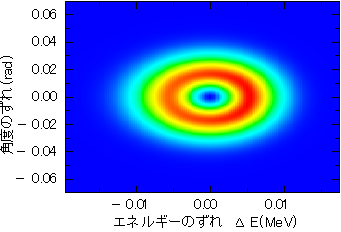
The "photon vortex" is a special quantum state with the specific angular momentum and coherent quantum phase in the macroscopic scale. It is thought to be easily generated in pulsars and gamma-ray bursts surrounding general-relativistic compact objects, i.e. neutron stars and black holes, and affect various cosmic phenomena. In the laboratory system, the "photon vortex" has already been generated as one of the modes of the ultra-high brightness laser, and the wide engineering application is expected. However, many theoretical works to clarify the nature of "photon vortex" was limited to the study in terms of classical electromagnetism. We have calculated, for the first time, the Compton scattering of electrons and the most fundamental "photon vortices", which are called Laguerre Gaussian waves, in relativistic quantum mechanics. On the basis of this successful result, it is highly desirable to make the next generation polarimeters capable of distinguishing "photon vortices" from circular polarized light, if they are equipped on the Satellite Observatory INTEGRAL-SPI or the solar power sailor IKAROS. With this apparatus, one would be able to observe more details of the magnetic fields and the electron energy at the source of the "photon vortex", which opens new era in the frontier research of magnetic field in space.
(2019/3/17)
T. Maruyama, T. Hayakawa, and T. Kajino, 2019, Sci. Rep, 9, 51
[Scientific Reports]
Toshitaka Kajino (personal website)
Can inhomogeneous primordial magnetic field solve the "Big-Bang lithium problem"?
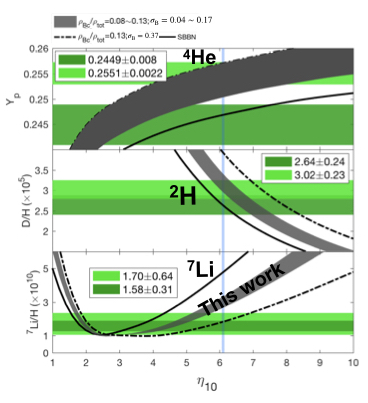
The standard model of Big Bang Nucleosynthesis (BBN) predicts primordial abundances of the light elements, except for 7Li, in reasonable agreement with observational constraints, which is called the "Big-Bang lithium problem" in the standard cosmology. We investigate the effects on BBN arising from the presence of a primordial magnetic field (PMF) whose strength is spatially inhomogeneous as expected from the observed CMB anisotropies. If the domains exhibit different temperatures from one another at the BBN epoch due to the fluctuations of local energy density of the PMF, the effective distribution function of particle velocities deviates from the Maxwell–Boltzmann distribution when it is averaged over the domains. Our BBN calculations by taking account of this effect of PMF fluctuations proved to reduce significantly the primordial 7Li abundance, thus relaxing the tension of "Big-Bang lithium problem".
(2019/3/1)
The figure shows that the abundances of 4He, D/H, and 7Li/H as a function of the baryon-to-photon ratio η. The boxes show the adopted observational constraints. The gray region shows that with inhomogeneous PMF, the 7Li abundance can be significant suppressed to a regime which is more consistent with the observations.
"Big Bang Nucleosynthesis with an Inhomogeneous Primordial Magnetic Field Strength"
Luo, et al. 2019, ApJ, 872,172
[arXiv]
[ADS]
Yudong Luo
Ignition of Type Ia Supernovae with Recent Experimental Carbon Fusion Cross Sections
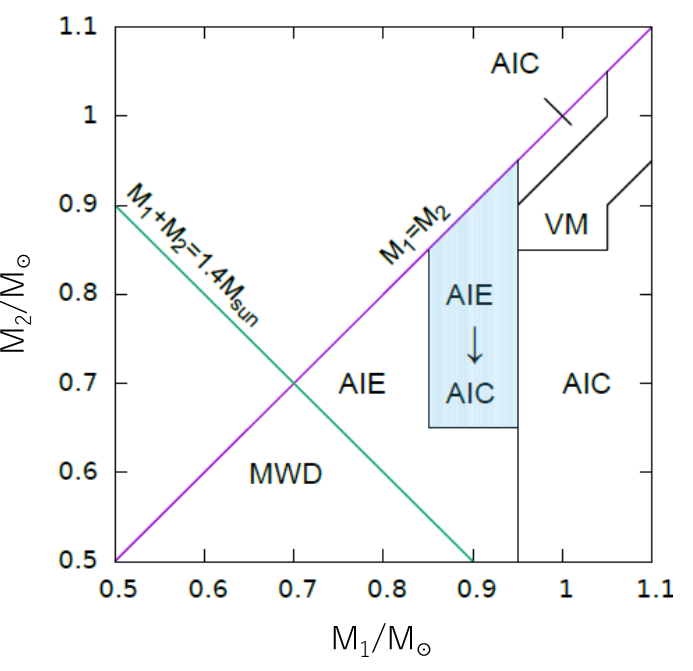
Type Ia supernovae are being used as the standard candle in cosmology, but their explosion mechanism is still unclear. They are thought to be the explosion of carbon-oxygen white dwarfs, and their ignition is triggered by the carbon fusion reactions. The cross sections of the carbon fusion were poorly known and subject to large uncertainties in the ignition condition of supernova explosions. A research group in Italy has recently reported a new experimental result in Nature, suggesting that the reaction rates are several tens of times larger than conventional ones due to molecular resonance. We evaluate theoretically if the reported resonance parameters are in reasonable agreement with quantum mechanical constraints and apply their new enhanced cross sections to the ignition of supernovae. It is found that white dwarf binary mergers tend to collapse to a neutron star at higher rate than exploding as a supernova.
(2019/2/22)
Figure: The fate of white dwarf mergers with and without the enhanced resonance contribution to carbon fusion reaction rate. M_1 is the mass of the primary star and M_2 the mass of the secondary. The blue region shows the systems whose fate changes, depending on the different reaction rates with and without the resonance.
"Impacts of the New Carbon Fusion Cross Sections on Type Ia Supernovae"
Kanji Mori, Michael A. Famiano, Toshitaka Kajino, Motohiko Kusakabe, Xiaodong Tang, 2019, MNRAS, 482, L70
[arXiv]
[ADS]
Kanji Mori
Little Supernova is Big Discovery: the Origin of Binary Neutron Stars
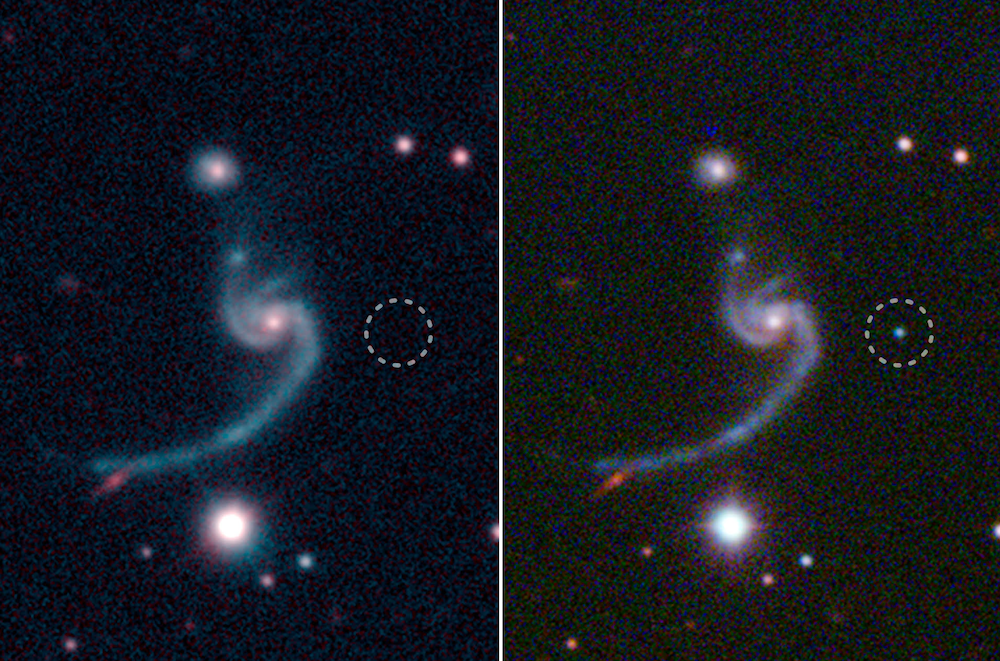
An international research team including Takashi Moriya at DTA/NAOJ discovered the first recorded "ultra-stripped supernova," a rare, faint type of supernova that is believed to play a role in the formation of binary neutron star systems. These findings will advance our understanding of a wide variety of topics ranging from gravitational waves to the origin of precious metals like gold and platinum. This research was published in Science on October 12, 2018.
See the full story: DTA Press Release "Little Supernova is Big Discovery: the Origin of Binary Neutron Stars"
(2018/10/12)
Figure: Red and green composite image from the Sloan Digital Sky Survey (SDSS) taken before supernova iPTF14gqr. Right: Red/green/blue composite image from the Palomar 60-inch telescope taken on October 19, 2014, during supernova iPTF14gqr. The circles indicate the position of the supernova. (Credit: SDSS/Caltech)
"A hot and fast ultra-stripped supernova that likely formed a compact neutron star binary"
K. De, M. M. Kasliwal, E. O. Ofek, T. J. Moriya et al., Science, Vol. 362, Issue 6411, pp. 201-206
[Science]
Takashi Moriya (personal website)
Cosmochronometer 98Tc is produced abundantly by supernova electron antineutrinos
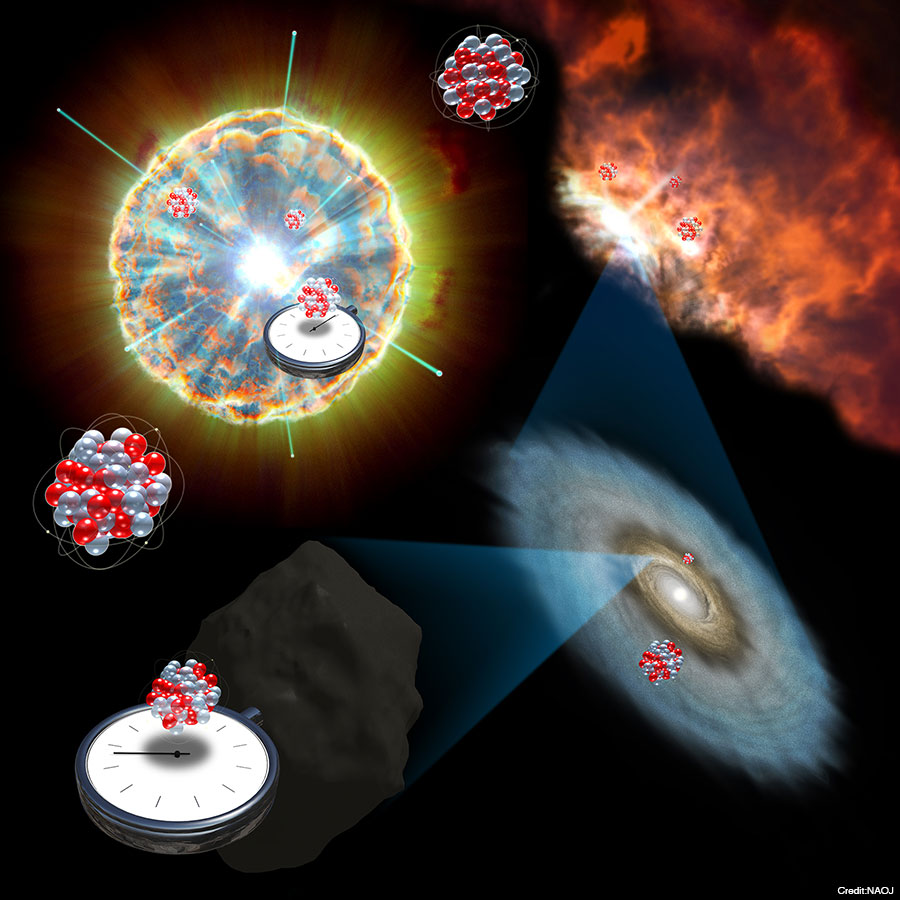
An international collaboration including Toshitaka Kajino and Motohiko Kusakabe (2018 NAOJ Visiting Professor) in the COSNAP group found that the short-lived nuclide 98Tc is produced significantly by reactions of electron antineutrinos with nuclei in supernovae. In the end of massive stellar evolution, supernovae occur and an extremely large number of neutrinos and antineutrinos are emitted from a neutron star in the center. The collaboration group calculated nucleosynthesis of 98Tc in supernovae taking into account neutrino and antineutrino reactions of preexisting nuclei. It was then shown that the charged-current anti-neutrino reactions significantly contribute to the production of 98Tc in supernovae. The 98Tc is the first nuclide whose production was found to be sensitive to the antineutrino energy spectrum. It is a potential chronometer for the time between the last supernova before the solar system formation and the meteoritic formation. Therefore, future measurements of its meteoritic abundance can be used to deduce the antineutrino spectrum and the time scale of the meteoritic formation.
Figure: Cosmic clocks. We can estimate the age of heavy elements in the primordial Solar System by measuring the traces left in meteorites by specific radioactive nuclei synthesized in certain types of supernovae. (Credit: NAOJ)
Details will be found in NAOJ web site .
Toshitaka Kajino (personal
website)
Nucleosynthesis Constraints on the Explosion Mechanism for Type Ia Supernovae

Type Ia supernovae (SNe Ia) play important roles in cosmology as a standard candle, although their progenitors and explosion mechanisms have been a long-standing mystery. One possible solution is to compare theoretical and observational nucleosynthetic yields, which needs careful collaboration among theories, observations, and experiments of astronomy and nuclear physics. Recent observations have revealed the abundances of radioactive elements including manganese, cobalt, iron, and nickel. We perform collaboration among researchers on supernova theories, astronomical observations, and experimental nuclear physics to calculate these abundances precisely. Comparison between the observed and the calculated isotopic ratios shows the way to diagnose explosion mechanisms of SNe Ia. In addition to that, it is pointed out that yields of some neutron-rich nuclei are good indicators of the density, therefore can constrain progenitors and explosion mechanisms if they are observed.
Figure: Elemental ratios of iron group elements from observations of supernova remnants and model calculations.
"Nucleosynthesis Constraints on the Explosion Mechanism for Type Ia Supernovae"
K. Mori, M. A. Famiano, T. Kajino, T. Suzuki, P. Garnavich, G. J. Mathews, R. Diehl, S. -C. Leung and K. Nomoto, The Astrophysical Journal, 863, 176
[ADS]
[arXiv]
Kanji Mori
Veiled Supernovae Provide Clue to Stellar Evolution

At the end of its life, a red supergiant star explodes in a hydrogen-rich supernova. By comparing observation results to simulation models, an international research team including Takashi Moriya at DTA/NAOJ found that in many cases this explosion takes place inside a thick cloud of circumstellar matter shrouding the star. This result completely changes our understanding of the last stage of stellar evolution. This research was published in Nature Astronomy on September 3, 2018.
Figure: Artist's impression of a red supergiant surrounded with thick circumstellar matter. (Credit: NAOJ)
See the full story: DTA Press Release "Veiled Supernovae Provide Clue to Stellar Evolution"
(2018/09/04)
"The delay of shock breakout due to circumstellar material evident in most type II supernovae"
F. Förster, T. J. Moriya et al. (2018) Nature Astronomy
[link]
Takashi Moriya (personal website)
Why are we all left handed? – Theory of elementary particle origin

International collaboration team among scientists at NAOJ, The University of Tokyo, Western Michigan University and Ohio State University has come up with a possible way in which Mother Nature selects left-handed amino acids in space. This new theory brings together fundamental particle physics, electromagnetism, biology, and chemistry. Molecules in magnetic fields can interact with leptons (some of the tiniest particles in nature which include electrons and neutrinos). Neutrino chirality is completely broken. Because leptons can also be chiral, they interact with amino acids differently depending on the combination of lepton chirality and amino acid chirality. This interaction can selectively destroy one mirror image more than the other, resulting in the imbalance that we see in meteorites. Since Louis Pasteur studied molecular chirality nearly 170 years ago, a question how amino acids got to be left-handed is one of the biggest questions in science. Not only does this discovery predict how amino acids got to be left-handed, it also predicts how they became left-handed in space. The ramifications for life on the earth and elsewhere in the cosmos are significant. The latest news on this discovery was published in Scientific Reports (a Nature journal) on Monday, June 11 at 10am GMT.
Illustration: The amino acid alanine in its left-handed form and right-handed form. The grey, red, blue, and white spheres are carbon, oxygen, nitrogen, and hydrogen respectively.
See also this link
(2018/06/18)
"Amino Acid Chiral Selection Via Weak Interactions in Stellar Environments: Implications for the Origin of Life"
Famiano M.A., Boyd, R.N, Kajino, T., Onaka, T., & Mo, Y., Scientific Reports, vol 8. (2018)
[link]
"Selection of Amino Acid Chirality via Neutrino Interactions with 14N in Crossed Electric and Magnetic Fields"
Famiano, M.A., Boyd, R.N., Kajino, T., & Onaka, T., Astrobiology 18, 190 (2018).
Toshitaka Kajino (personal
website)
New simulations of terrestrial planet formation
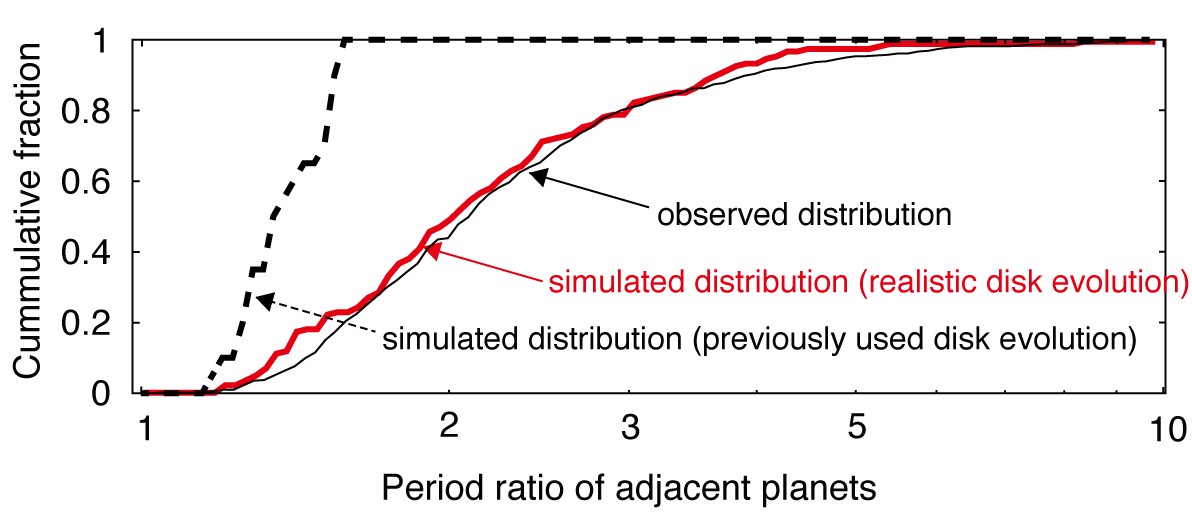
It is widely accepted that planets form in a gaseous disk (or a
protoplanetary disk) that surrounds the star. As the disk affects
planet formation processes in several ways, the evolution and property
of the disk is crucial in studying the planet formation. We study
formation of terrestrial planets by numerical simulations that take
into account recent developments of the disk evolution theory (e.g.,
magnetically driven disk winds). We found that the localized
configuration of the terrestrial planets of the solar system can be
reproduced by the radial drift of small bodies due to the effect of
disk winds. We also showed that the origin of observed properties of
close-in super-Earths can be explained by considering the realistic
evolution of a protoplanetary disk (see figure).
(2018/06/18)
Ogihara, Kokubo et al. 2018, A&A, 612, L5
[ADS]
[arXiv]
Ogihara, Kokubo et al. 2018, A&A, in press
[ADS]
[arXiv]
Masahiro Ogihara (personal
website)
FY 2017
Rare first moment of stellar explosion captured by amateur astronomer

Unprecedented observations by an amateur astronomer revealed the exact moment when a supernova became visible in the sky. The data allowed a team of researchers to test theoretical predictions about the initial evolution of such stellar explosions. Their models indicate that the dramatically rapid brightness rise observed was due to the emergence of the explosive shockwave at the star’s surface. Such a phenomenon, known as shock breakout had long been predicted by theory and was being sought for by several groups around the globe. It required a very lucky –- and watchful –- amateur astronomer to finally catch the moment. The results were published in Nature on February 22, 2018 by the Argentine team and colleagues from Japan, USA, and Europe including Dr. Masaomi Tanaka and Dr. Takashi Moriya at DTA/NAOJ.
See the full story:
Kavli IPMU Press Release: "Rare first moment of stellar explosion captured by amateur astronomer"
(2018/02/22)
Figure: Sequence of combined images obtained by Víctor Buso as SN 2016gkg arises in the outskirts of galaxy NGC 613. Labels indicate the time each image was taken. The supernova location is indicated by the red circles. Notably the supernova appears and stabrightens and steadily brightens within one hour, as shown in the lower-right panel. (Credit: Bersten et al.)
"A surge of light at the birth of a supernova", M. C. Bersten et al., 2018, Nature [Nature]
Masaomi Tanaka
[personal webpage]
Takashi Moriya
[personal webpage]
Discovery of a supernova beyond the standard explosion paradigm
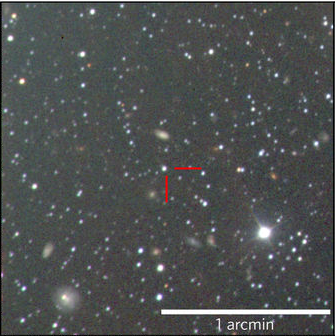
An international research team discovered a supernova that cannot be explained by the current standard theory of supernova explosions. The supernova, named OGLE-2014-SN-074 (OGLE14-073 hereafter), was more than 10 times more energetic than supernovae of a similar kind. OGLE14-073 could be a new kind of supernovae whose existence has been predicted theoretically but has never been observed. This research was published online in Nature Astronomy on September 18, 2017.
See the full story:
"Discovery of a supernova beyond the standard explosion paradigm"
(2017/11/06)
Figure: OGLE14-073 observed on September 24, 2014. The image was taken with the ESO Faint Object Spectrograph (EFOSC) on the NTT telescope operated by the European Sourthern Observatory (ESO). (Credit: Terreran et al. (2017) Nature Astronomy)
"Hydrogen-rich supernovae beyond the neutrino-driven core-collapse paradigm", Terreran et al., 2017, Nature Astronomy [Nature Astronomy]
Takashi Moriya
[personal webpage]
Astronomers Follow Gravitational Waves to Treasure
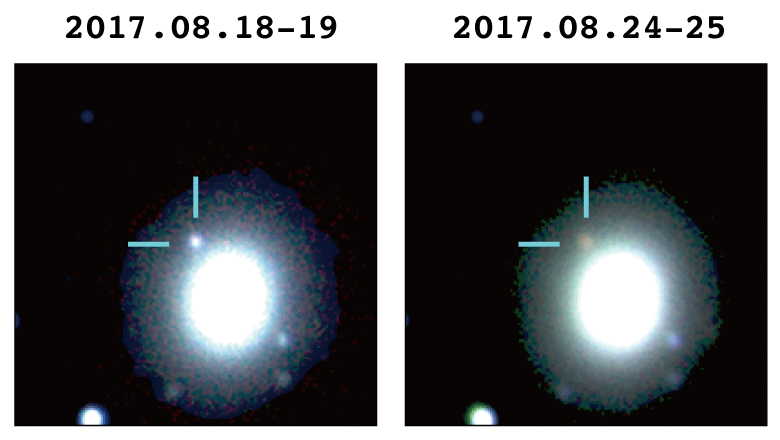
The research group J-GEM has performed optical and near-infrared follow-up observations of the gravitational wave source GW170817, which was observed with Advanced LIGO and Advanced Virgo on August 17, 2017. The group has successfully detected the optical and near-infrared counterpart of GW170817 and followed the time evolution of its brightness. GW170817 is the first case of gravitational wave detection from a neutron star merger. The observed properties of the counterpart of GW170817 can be accounted for by a "kilonova", which is light powered by the radioactive decay of elements newly-synthesized in a neutron star merger. These results strongly suggest that heavy elements such as gold and platinum are being synthesized via the "r-process" in the neutron star merger GW170817.
The Subaru Telescope in Hawai`i, 1.4-m IRSF telescope in South Africa, 1.8-m MOA-II telescope in New Zealand, and some other Japanese telescopes joined the follow-up observations. The ATERUI supercomputer was used for the theoretical research of "kilonovae." The important findings in "multi-messenger astronomy" benefited from the collaboration between the gravitational wave and optical/infrared observations, and the simulations.
See the full story:
Subaru Telescope Press Release: "Optical/Infrared Telescopes Follow Gravitational Waves to Treasure"
CfCA Press Release: "Astronomers Follow Gravitational Waves to Treasure"
(2017/10/16)
Figure: Three-color false-color composite images showing the time evolution of the optical and near-infrared counterpart of GW170817 made using data from the Subaru Telescope and IRSF. (Credit: NAOJ/Nagoya University)
“J-GEM observations of an electromagnetic counterpart to the neutron star merger GW170817”, Utsumi et al., 2017, PASJ [PASJ]
“Kilonova from post-merger ejecta as an optical and near-Infrared counterpart of GW170817”, Tanaka et al., 2017, PASJ [PASJ]
“Subaru Hyper Suprime-Cam Survey for An Optical Counterpart of GW170817”, Tominaga et al., 2017, submitted to PASJ [ADS]
Masaomi Tanaka
[personal webpage]
Surface Helium Detonation Spells End for White Dwarf
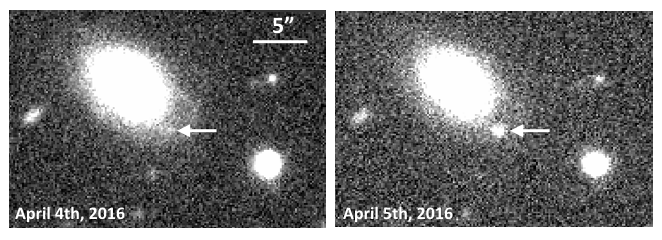
An international team of researchers has found evidence that the brightest stellar explosions in our Universe could be triggered by helium nuclear detonation near the surface of a white dwarf star. Using Hyper Suprime-Cam mounted on the Subaru Telescope, the team detected a type Ia supernova within a day after the explosion, and explained its behavior through a model calculated using the supercomputer ATERUI. This result was reported in Nature published on Oct. 5.
See the full story:
Subaru Telescope Press Release: "Surface Helium Detonation Spells End for White Dwarf"
CfCA Press Release: "Surface Helium Detonation Spells End for White Dwarf"
(2017/10/05)
Figure: A type Ia supernova detected within a day after exploding. Taken with Hyper Suprime-Cam mounted on the Subaru Telescope. (Credit: The University of Tokyo / NAOJ)
"A hybrid type la supernova with an early flash triggered by helium-shell detonation"
Jiang et al., 2017, Nature 550, 80–83
[Nature]
Masaomi Tanaka
[personal webpage]
The effect of collective neutrino oscillations on vp process nucleosynthesis
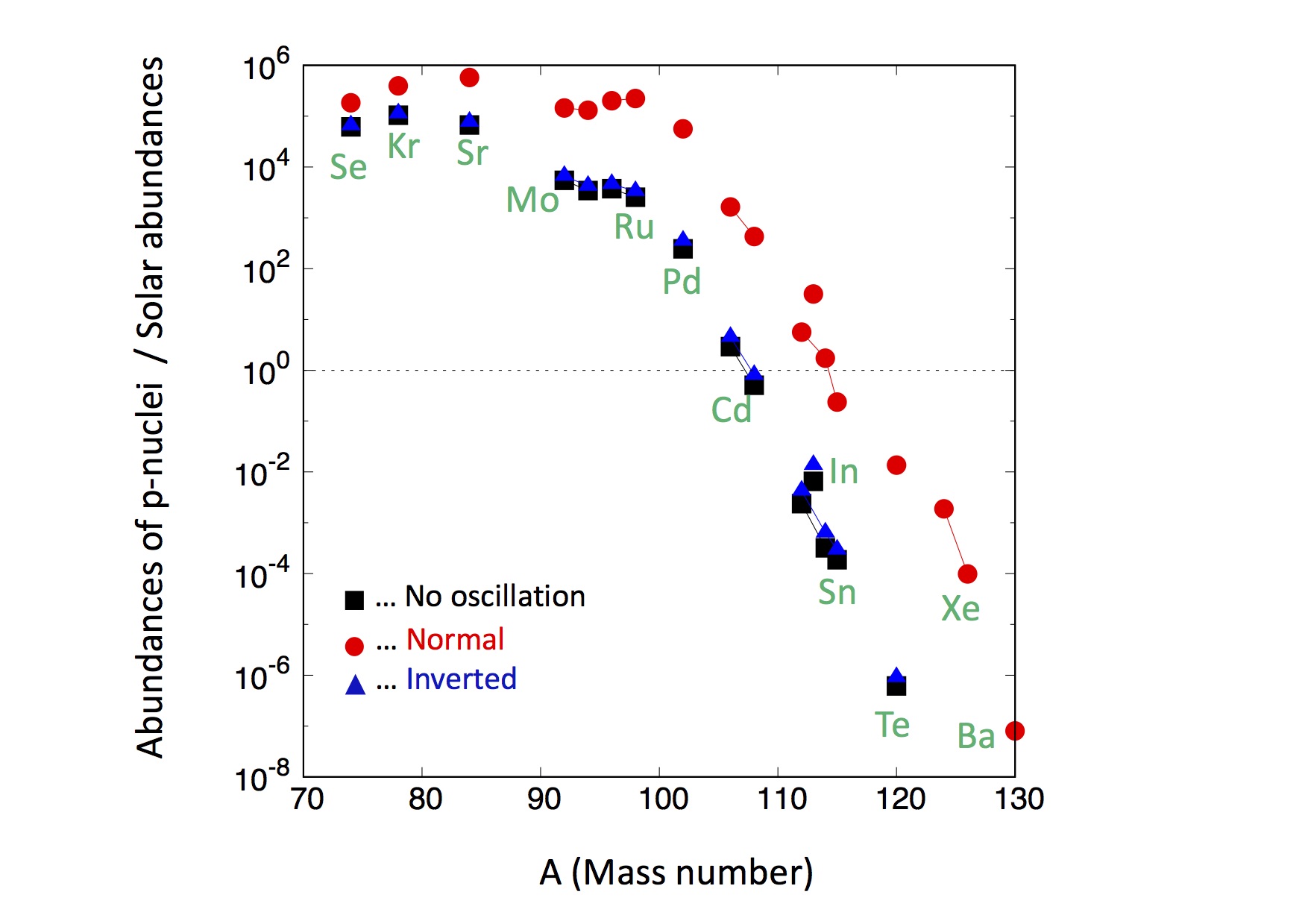
In core collapse supernovae, large numbers of neutrinos are emitted from the protoneutron star after core bounce. At such high neutrino number densities, neutrino-neutrino coherent scatterings cause a non-linear phenomenon called "collective neutrino oscillation" which results in the dramatic flavor transition in neutrino and antineutrino spectra. There was no quantitative study which took into account the influence of collective neutrino oscillations on the vp-process nucleosynthesis consistently. In this work, we study the impact of collective neutrino oscillations on the vp process nucleosynthesis by combining realistic three flavor multiangle simulations with nucleosynthesis network calculations for the first time. We find that the abundances of p-nuclei which are synthesized in the vp process are enhanced by oscillation effects by 10-10^4 times in normal mass hierarchy. Our results imply the necessity of collective neutrino oscillations for the precise nucleosynthesis in neutrino-driven winds and also help understand the origin of solar-system isotopic abundances of molybdenum 92,94 and ruthenium 96,98.
(2017/10/02)
Figure: The abundances of p-nuclei inside neutrino-driven winds which are normalized by solar isotopic abundances. In normal mass hierarchy (red point), the abundances of p-nuclei are enhanced by collective neutrino oscillations compared with no oscillation case (black point).
"Possible effects of collective neutrino oscillations in three-flavor multiangle simulations of supernova vp processes"
Hirokazu Sasaki, Toshitaka Kajino, Tomoya Takiwaki, Takehito Hayakawa, Baha Balantekin, and Yamac Pehlivan
2017, Physical Review D, 96, 043013
[PRD]
[arXiv]
Hirokazu Sasaki
Efficiency of Metal Mixing in Dwarf Galaxies
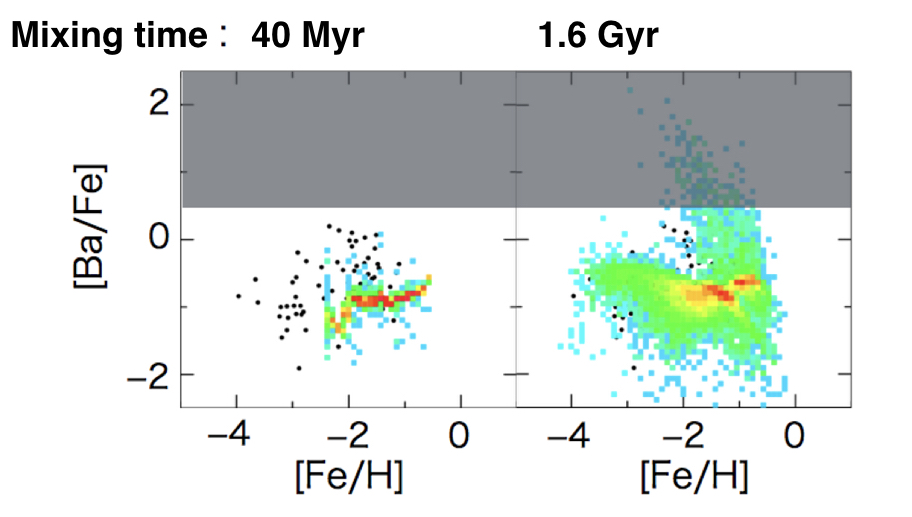
Dwarf galaxies have the fewer number of stars with high r-process abundances than those of the Milky Way halo. Metal mixing processes in the early phase of galaxy formation deeply relate to these difference of the elemental abundances. However, the efficiency of metal mixing in galaxies is not yet understood. Here we performed a series of chemodynamical simulations of dwarf galaxies with turbulence-induced metal mixing model. We found that the efficiency of metal mixing is larger than 1/10 of the efficiency estimated the turbulence theory. We also found that timescale of metal mixing is less than 40 Myr. This timescale is shorter than that of typical dynamical times of dwarf galaxies.
(2017/09/01)
Figure: [Ba/Fe] as a function of [Fe/H] of our model prediction (color gradation) and observations of dwarf galaxies (dots). Gray shaded region represents the region without observations. Left and right panels show models with metal mixing timescale of 40 Myr and 1.6 Gyr, respectively.
“Efficiency of Metal Mixing in Dwarf Galaxies”
Yutaka Hirai, Takayuki R. Saitoh
2017, The Astrophysical Journal Letters, 838, L23
[ADS]
[arXiv]
Yutaka Hirai
[personal webpage]
ALMA polarization observation of the protoplanetary disk around HL Tau
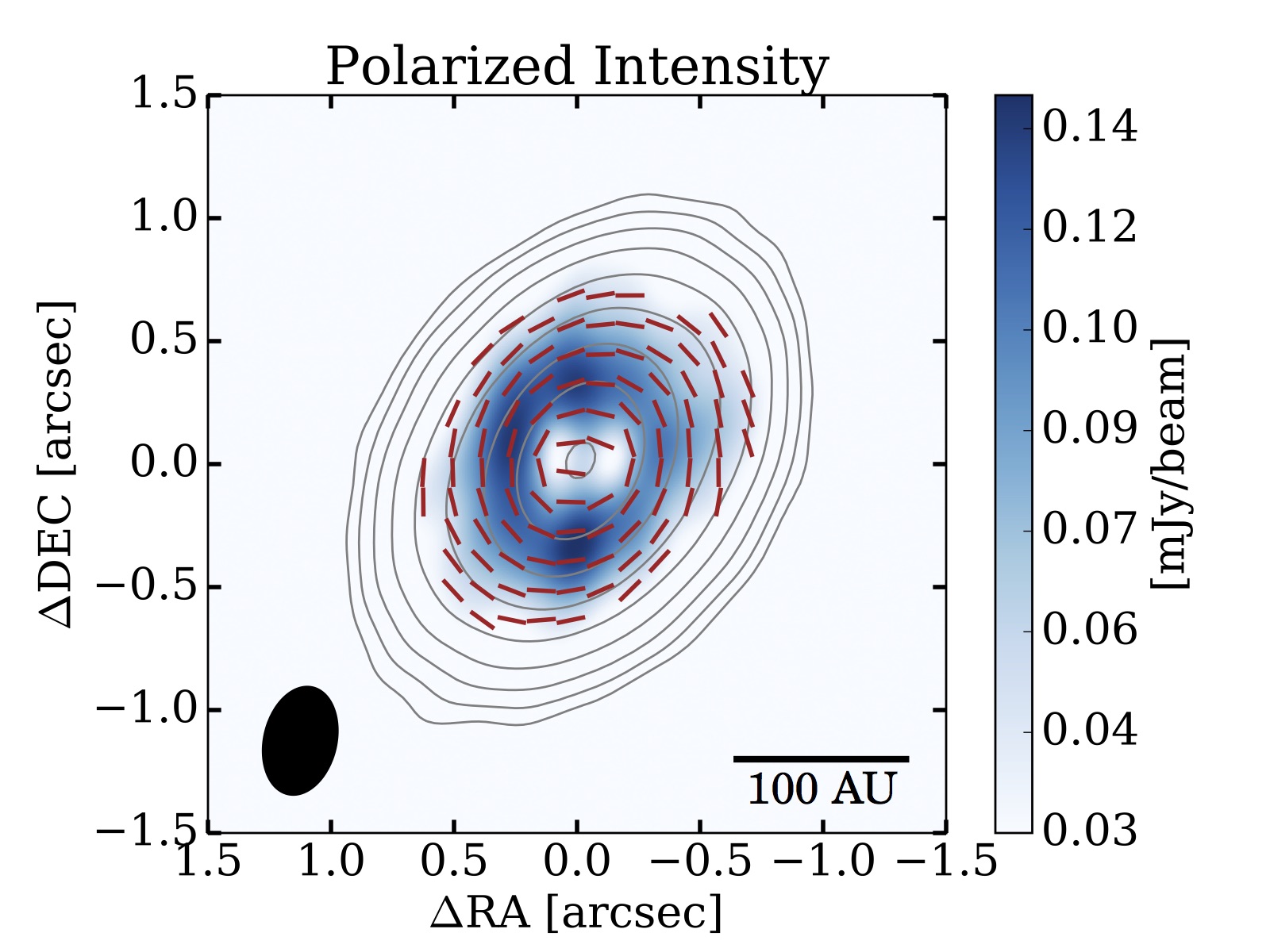
Planets form in protoplanetary disks via dust coagulation. Then, how can we measure the size of growing dust grains? We have theoretically proposed that we can constrain the grain size from millimeter-wave polarization observations of protoplanetary disks, produced by dust scattering. In this context, we observe the protoplanetary disk around HL Tau, which shows multi-ring structure presumably caused by unseen planets in the gaps, with the ALMA polarization mode. We find that the polarization is produced not by the grain alignment with magnetic fields but by the combination of the grain alignment with the radiation fields and the self-scattering of thermal dust emission, which we proposed in 2015. Also, by modeling the self-scattered component, we find that the dust grains have a size of 100 micron in the protoplanetary disk.
(2017/07/07)
"The evidence of radio polarization induced by the radiative grain alignment and self-scattering of dust grains in a protoplanetary disk"
Kataoka et al., ApJL, in press
[arXiv]
Akimasa Kataoka [personal webpage]
First Global Simulation Yields New Insights into Ring System
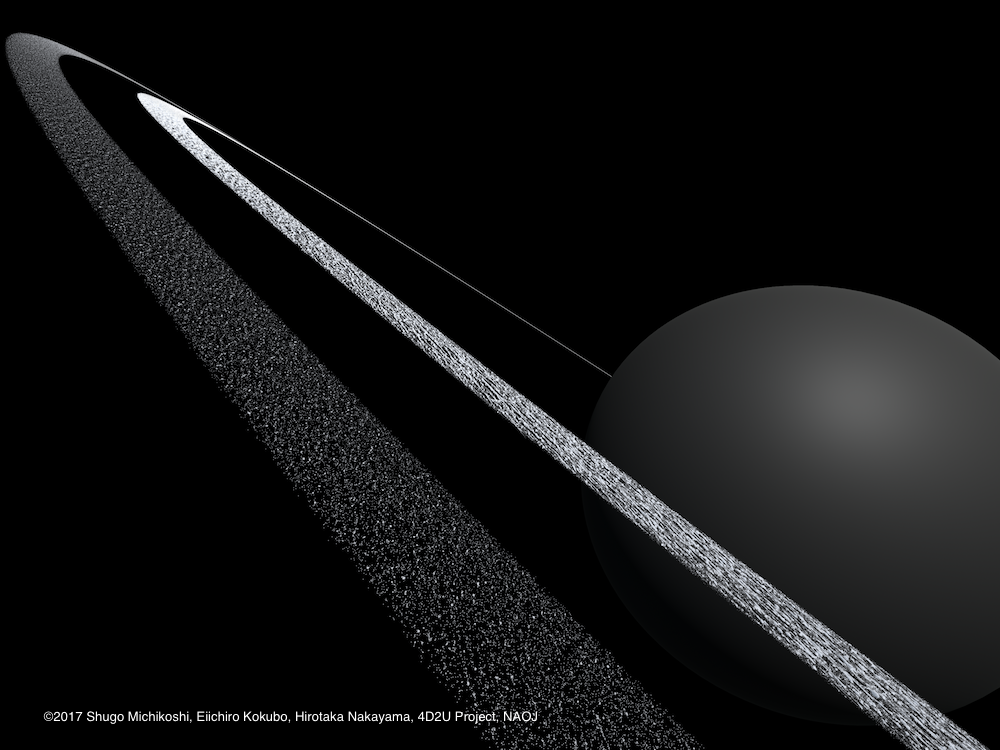
A team of researchers in Japan modeled the two rings around Chariklo, the smallest body in the Solar System known to have rings (Figure 1). This is the first time an entire ring system has been simulated using realistic sizes for the ring particles while also taking into account collisions and gravitational interactions between the particles. The team’s simulation revealed information about the size and density of the particles in the rings. By considering both the detailed structure and the global picture for the first time, the team found that Chariklo’s inner ring should be unstable without help. It is possible the ring particles are much smaller than predicted or that an undiscovered shepherd satellite around Chariklo is stabilizing the ring.
(2017/04/28, CfCA Press Release)
Figure: Visualization constructed from simulation of Chariklo’s double ring. (Credit: Shugo Michikoshi, Eiichiro Kokubo, Hirotaka Nakayama, 4D2U Project, NAOJ)
"Simulating the Smallest Ring World of Chariklo"
Shugo Michikoshi and Eiichiro Kokubo, ApJL, 837, L13, 2017.
[ApJL]
Eiichiro Kokubo
FY 2016
An Elegant Solution of the Big-Bang Lithium Problem?
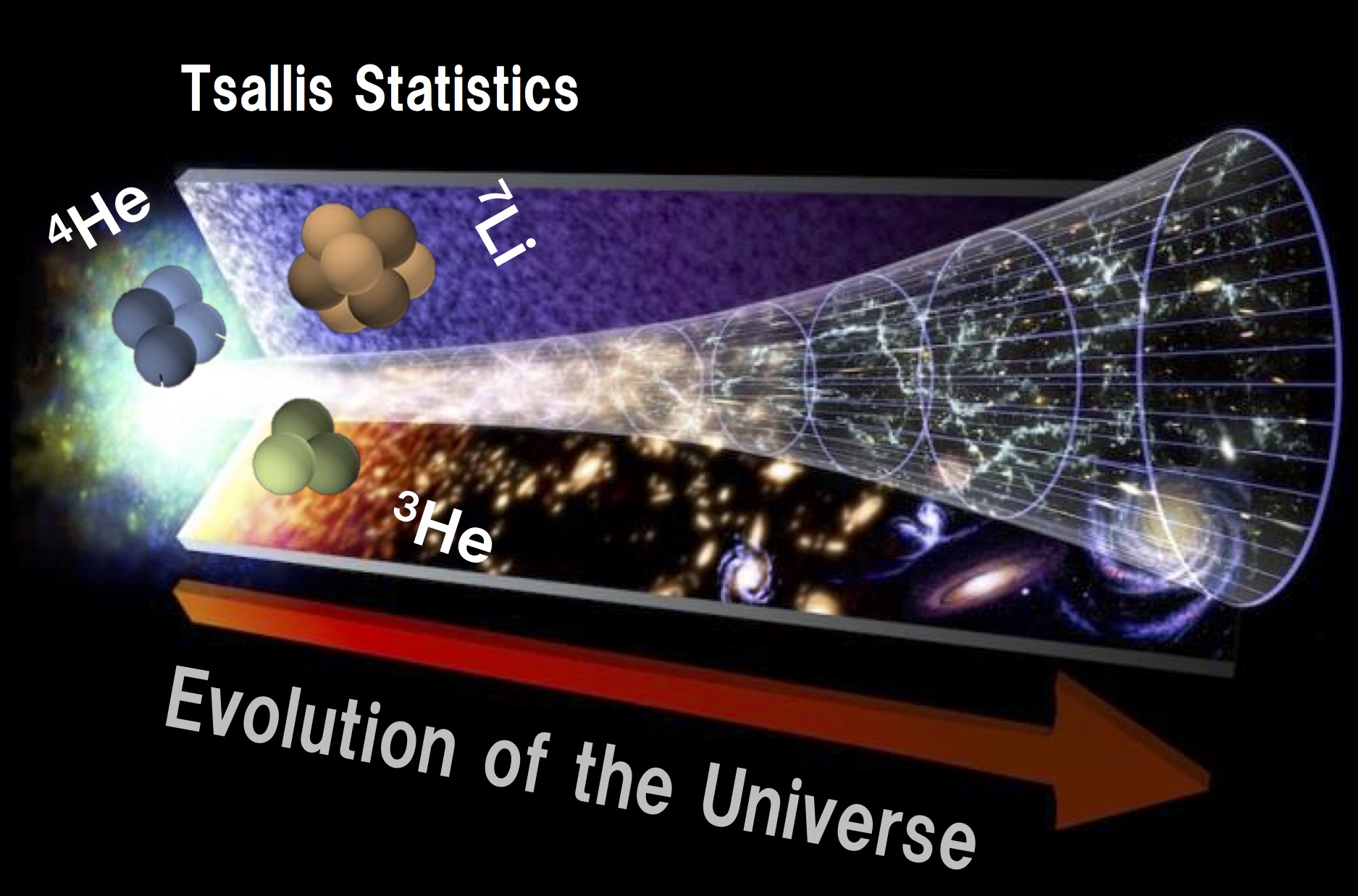
The success of a theory of the CMB fluctuation and anisotropies and the observations of cosmic large-scale structure are thought to be a piece of evidence that the Big-Bang theory, which was first proposed by George Gamow in 1948, is the robust theoretical model of the cosmic expansion. However, this model predicts too large primordial abundance of lithium (atomic number Z=3) among all other light elements and contradicts astronomical observations of the early generations of old metal-poor stars. This discrepancy is called "the Big-Bang lithium problem" which might indicate the breakdown of the standard Big-Bang cosmology or suggest the need of a new particle-cosmological theory beyond the standard model. Elementary particles and nuclei in the hot Big-Bang expansion of the early Universe are not necessarily obey the classical Maxwell-Boltzmann distribution but some other class of non-extensive statistics. Tsallis statistics are the one of them which is presumed to describe well the thermodynamic systems showing chaos or fractals. Our international collaboration team demonstrated to solve this long standing Big-Bang lithium problem by applying Tsallis statistics to the primordial nucleosynthesis. If this "elegant solution" is correct, the Big Bang theory is now one step closer to fully describing the formation of our Universe, as referred in AAS NOVA (link).
(2017/03/04)
Figure: Primordial nucleosynthesis in the early hot Big-Bang expansion and the evolution of the Universe (taken from AAS NOVA) (C) NASA.
"Non-extensive Statistics to the Cosmological Lithium Problem"
S. Q. Ho, et al. with T. Kajino 2017, Astrophys. J. 834, 165.
[ApJ]
Taka Kajino
Early evolutionary histories of galaxies deduced from r-process elements
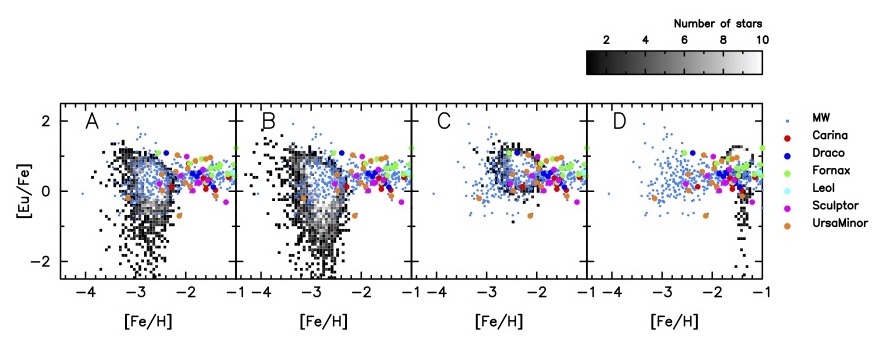
Abundances of r-process elements such as Eu and Ba in extremely metal-poor stars may reflect the early evolutionary histories of galaxies. However, how the chemo-dynamical evolution of galaxies affects the abundance of r-process elements is not yet understood. In this study, we perform a series of N-body/hydrodynamic simulations of galaxies with different density and mass. We calculate the evolution of r-process abundances in these galaxies. We find that galaxies with dynamical times around 100 Myr have star formation rates of less than 10-3 Msun/year and they reproduce the observed r-process abundances (Figure A and B). This result does not depend on the mass of halos. On the other hand, r-process elements appear higher metallicity in galaxies with dynamical times around 10 Myr (Figure C and D). We also find that galaxies with lower star formation rates need longer timescale to mix metals, resulting in larger dispersions of r-process abundance ratios. This study demonstrates that future observations of r-process
elements in extremely metal-poor stars will be able to constrain the evolutionary histories of galaxies.
(2017/02/20)
Figure: [Eu/Fe] as a function of [Fe/H]. Grey scale represents model prediction. From left to right, we plot models with initial dynamical times of 100 Myr (A), 70 Myr (B), 30 Myr (C and D). Model D has a different density profile with other models. Small and large dots are observed abundances in the Milky Way halo and dwarf galaxies.
“Early chemo-dynamical evolution of dwarf galaxies deduced from enrichment of r-process elements”
Yutaka Hirai, Yuhri Ishimaru, Takayuki R. Saitoh, Michiko S. Fujii, Jun Hidaka and Toshitaka Kajino
2017, Monthly Notices of Royal Astronomical Society, 466, 2474
[ADS]
[arXiv]
Yutaka Hirai [personal webpage]
Mystery of Nucleosyntheis in Type Ia Supernova: Challenge from Precise Nuclear Physics
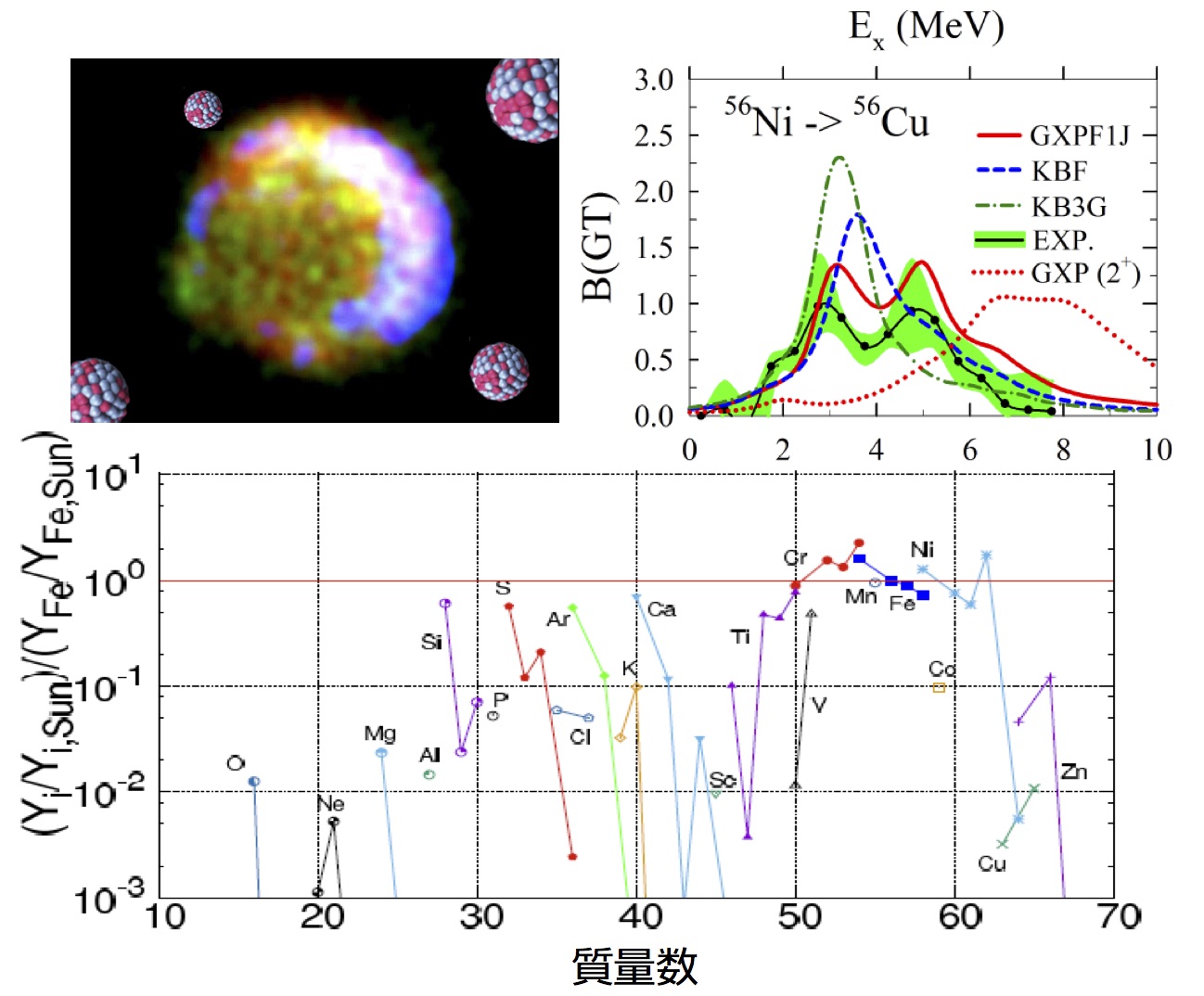
Type Ia supernovae (SNe Ia) are one of the most energetic phenomena in the Universe, and have ever been used as cosmic ladder to discover the accelerating cosmic expansion. However, the details of the explosion mechanism are still unclear. Under an extremely high temperature and density condition in the celestial phenomena like SNe Ia, electrons are successively captured by radioactive nuclei and affect explosive nucleosynthesis. Recent theoretical prediction of the electron capture (EC) rates (i.e. equivalently Gamow-Teller strengths) of some unstable nuclei has proved to be consistent with precise experimental measurements. According to the theoretical prediction, the EC rates differ from those used in the previous conventional calculations. In the present study therefore we systematically calculate the EC rates using new generation nuclear shell model, and apply the results to network calculations of SN Ia nucleosynthesis. As a result, we find that the overproduction problem in the abundances of neutron-excess Cr-Fe-Ni isotopes is solved and that the solar-system abundances from Si to Ni are well reproduced systematically in our late-detonation wind model of SN Ia.
(2017/02/02)
Figure: (Upper left) Image of Tycho's supernova remnant taken by Suzaku (C) RIKEN.
(Upper right) Newly calculated Gamow-Teller strengths.
(Lower) Theoretical prediction of the isotopic abundances relative to the solar-system abundances.
"Impact of New Gamow-Teller Strengths on Explosive Type Ia Supernova Nucleosynthesis"
Kanji Mori et al., 2016, ApJ, 833, 179.
[ADS]
Kanji Mori
Metallic Iron Grains Hardly Exist in the Universe

A research group consisting of Hokkaido University, JAXA, and NAOJ
replicated the formation of Fe grains in gaseous ejecta of evolved stars
by means of microgravity experiments aboard the sounding rocket S-520-28.
They found that the sticking probability for the formation of Fe grains
is extremely small, approximately 0.002%;
only a few atoms will stick per hundred thousand collisions so that
homogeneous nucleation of metallic Fe grains is highly ineffective,
even in the Fe-rich ejecta of Type Ia supernovae.
This implies that most Fe is locked up as grains of Fe compounds or as
impurities accreted onto other grains in the interstellar medium.
See web release
from Hokkaido University (only in Japanese) for more details.
(2017/01/31)
"Pure iron grains are rare in the universe",
Yuki Kimura, Kyoko, K. Tanaka, Takaya Nozawa, Shinsuke Takeuchi, Yuko
Inatomi
2017, Science Advances, 3, 1
[journal]
Takaya Nozawa
[personal webpage]
Cosmic lenses Bring the Universe’s Expansion into Sharper Focus

By using distant galaxies as giant gravitational lenses, an international group of astronomers has made an independent measurement of how fast the Universe is expanding. The study was enabled by a powerful combination of ground-based telescopes including those on Maunakea – Subaru Telescope, Canada-France-Hawaii Telescope, Gemini Observatory, and W. M. Keck Observatory – as well as the space based NASA/ESA Hubble Space Telescope and Spitzer Space Telescope. The newly measured expansion rate for the local Universe has incredibly high accuracy and is consistent with earlier findings. These independent measurements of the Hubble constant offer insights into the overall structure of the Universe. Dr. Kenneth C. Wong of NAOJ is a part of the H0LiCOW collaboration and led an key part of the analysis.
see Webrelease from Subaru Telescope for more details.
(2017/01/29)
New classes of electron orbits in magnetic reconnection
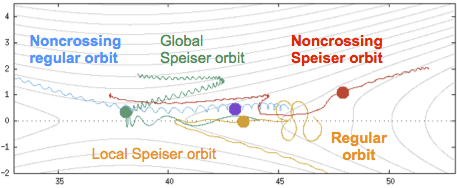
Magnetic reconnection, an explosive energy-release process in space plasmas,
is mediated by complex particle motion of plasmas.
The electron motion is one of the smallest elements in reconnection systems, and
has long been studied by using particle-in-cell (PIC) simulations.
However, as PIC data have become larger and larger in size,
it has become more and more difficult to diagnose particle orbits in simulations.
In this work, we extensively analyzed twenty million electron trajectories
during magnetic reconnection by using a 2D PIC simulation,
so as not to overlook any interesting trajectories.
As a result, we discovered various electron orbits
that have never been discussed before.
The figure displays typical electron trajectories in magnetic reconnection,
in which the new orbits are indicated with bold faces.
Surprisingly, it was found that a majority of the electrons follow the new orbits.
This raises a serious question to previous discussions
on the basis of the conventional electron orbits.
Taking the noncrossing populations into account,
various theoretical issues need to be revised.
This paper was selected as one of highlight papers, from the 19 journals published by the American Institute of Physics.
(2016/10/05)
S. Zenitani and T. Nagai, Phys. Plasmas 23, 102102 (2016)
Seiji Zenitani (private website)
Avoiding “Traffic Jam” Creates Impossibly Bright “Lighthouse”
A supercomputer recreated a blinking impossibly bright “monster pulsar.”
The central energy source of enigmatic pulsating Ultra Luminous X-ray sources (ULX) could be a neutron star according to numerical simulations performed by a research group led by Tomohisa Kawashima at the National Astronomical Observatory of Japan (NAOJ).
see web release from CfCA for more details.
(2016/09/08)
Kawashima, T., Mineshige, S., Ohsuga, K. and Ogawa, T., 2016, PASJ, published online
[PASJ]
[arXiv]
Kawashima, T. (NAOJ), Mineshige, S. (Kyoto U.), Ohsuga, K. (NAOJ) and Ogawa, T. (Kyoto U.)
Japan OISTER collaboration uncovers the origin of extraordinary supernovae
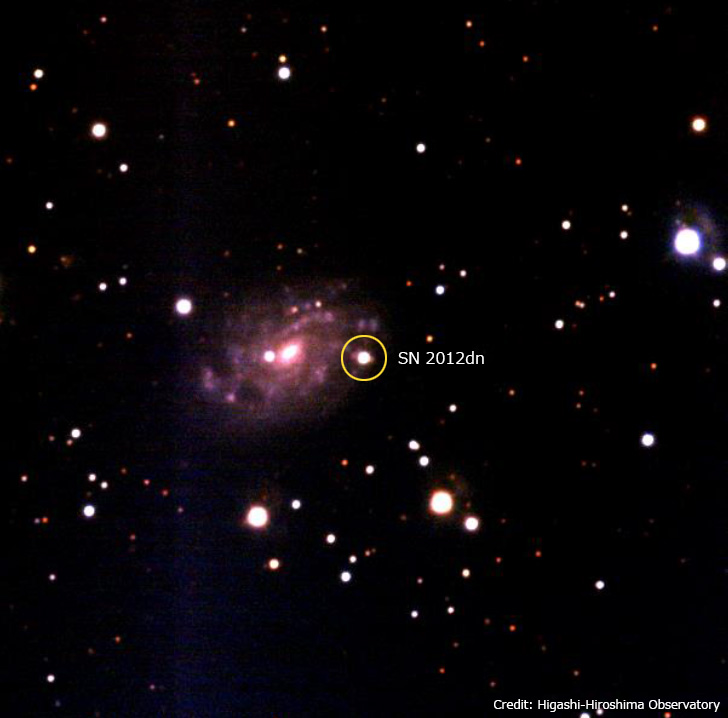
A group led by researchers in Konan University, Kyoto University, and NAOJ demonstrated that the origin of extraordinary supernovae can be explained by the "accretion scenario", using data obtained through the Optical and Infrared Synergetic Telescopes for Education and Research (OISTER) in Japan.
For more details, please visit web release (Konan University)、web release (NAOJ).
(2016/06/07)
Yamanaka, M., Maeda, K., Tanaka, M., et al. 2016, PASJ, publised online
[ADS]
[arXiv]
Masayuki Yamanaka (Konan University)、Keiichi Maeda (Kyoto University)、Masaomi Tanaka (NAOJ)
FY 2015
Conversion of Hadronic Matter to Quark Matter in Neutron
Stars
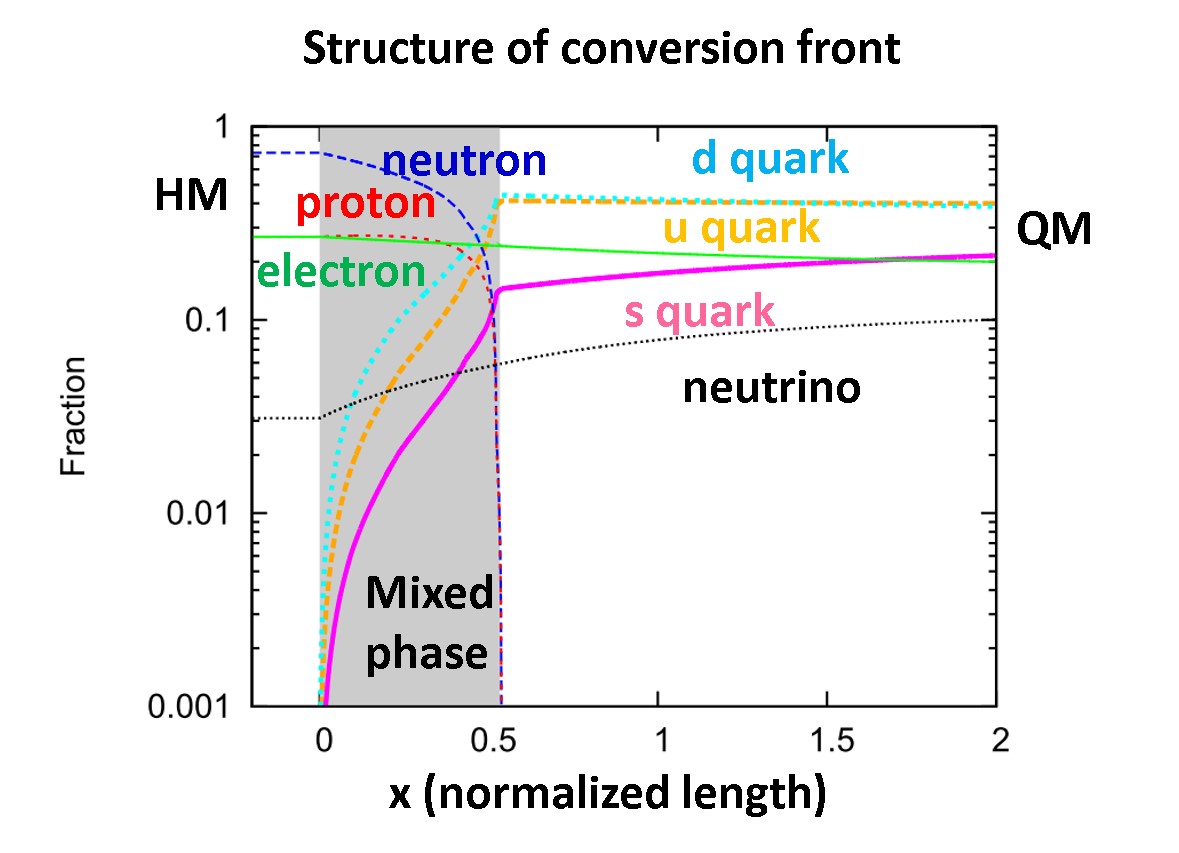
We study transitions of hadronic matter (HM) to quark matter (QM) in
neutron stars.We not only pay attention to the structures inside the
conversion front by taking into account what happens during the
conversion processes on the time scale of weak interactions. We
demonstrated that the combustion will occur in the so-called
endothermic regime and there are different characteristics of the
mixed state of HM and QM and the appearance of strange quarks.We find
that the laminar front is unstable in the exothermic regime but
stable in the endothermic regime, which is quite contrary to the
ordinary combustion.
(2016/3/31)
"Hydrodynamical study on the conversion of hadronic matter to quark
matter: I. Shock-induced conversion",
Shun Furusawa, Takahiro Sanada, and Shoichi Yamada
Phys. Rev. D 93, 043018
[Journal]
[ADS]
[arXiv]
"Hydrodynamical study on the conversion of hadronic matter to quark
matter: II. Diffusion -induced conversion",
Shun Furusawa, Takahiro Sanada, and Shoichi Yamada
Phys. Rev. D 93, 043019
[Journal]
[ADS]
[arXiv]
Shun Furusawa [personal webpage]
New Model on the Origin of the Heavy Elements:
Solving the Underproduction Problem of the r-Process
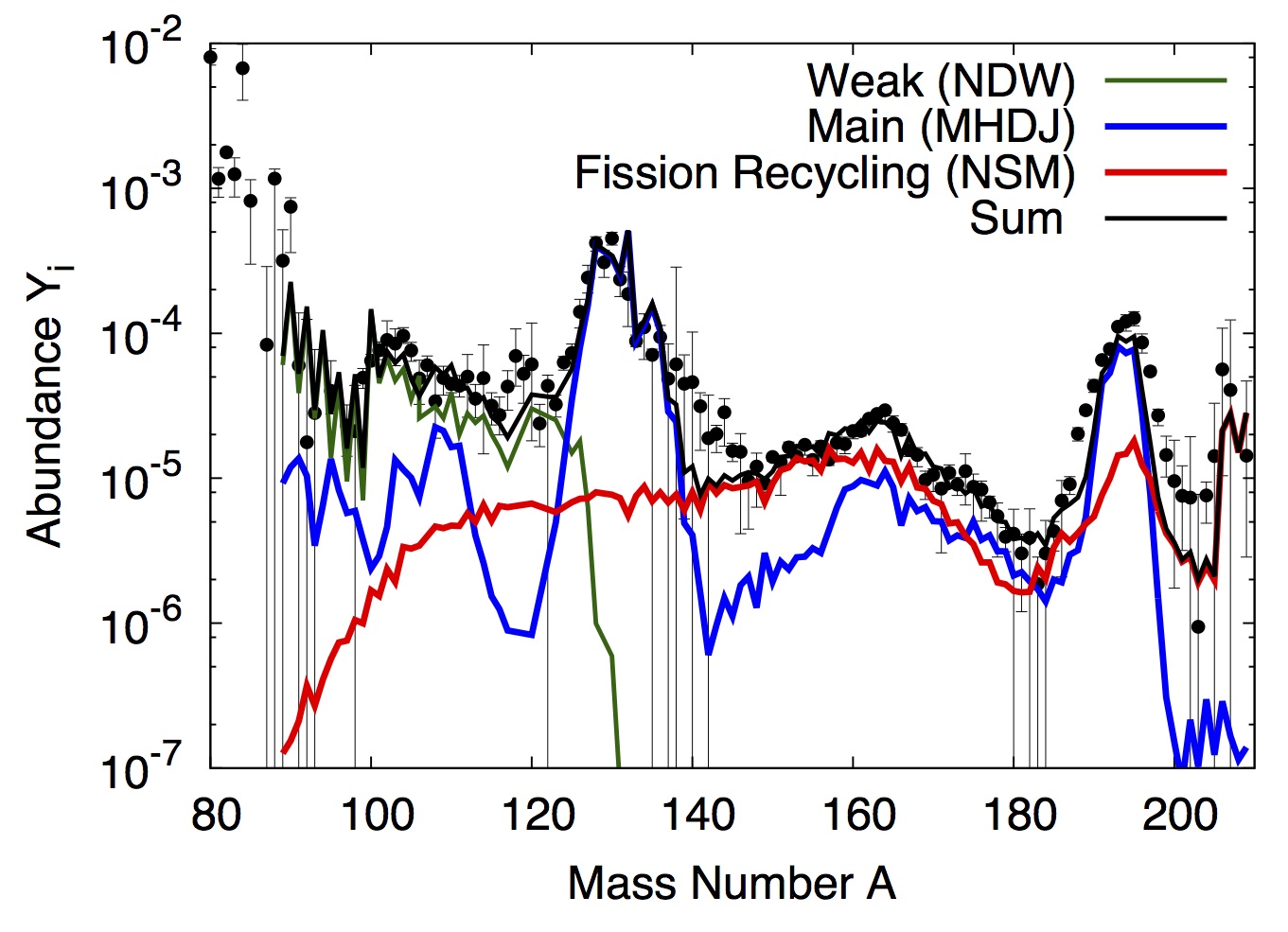
The origin of heavy elements like gold and uranium, called r-process elements, is one of the 11 Greatest Unanswered Questions of the Century in Particle & Nuclear Physics and Astronomy (see Discover magazine). Shota Shibagaki and Taka Kajino in COSNAP International Consortium(link)proposed a new theoretical model that the r-process elements were produced in supernova explosions from the early Galactic evolution, followed later by the additional contribution from the binary neutron-star mergers after 100 Myr of cosmic time. In this theoretical model, a long-standing underproduction problem of the isotopic abundances above and below the typical r-process peaks around A = 130, 165 and 195 is resolved, still satisfying the universal r-process abundance pattern between the early generations of metal-deficient stars and the solar-system.
Figure: Solar-system isotopic r-prpcess abundance pattern. Observation (black dots) vs. theoretical calculation which consists of the r-process in magnetohydrodynamic jet supernova model (blue), neutrino-heated supernova model (green), binary neutron-star merger model (red) and total sum (black).
(2016/03/25)
Relative contributions of the weak, main and fission-recycling r-process
S. Shibagaki, T. Kajino, G. J. Mathews, S. Chiba, S. Nishimura, and G. Lorusso,
Astrophys. J. 816 (2016), 79.
[Journal]
[ADS]
[arXiv]
Shota Shibagaki
Toshitaka Kajino (personal website)
Galactic Spiral Arms by Swing Amplification
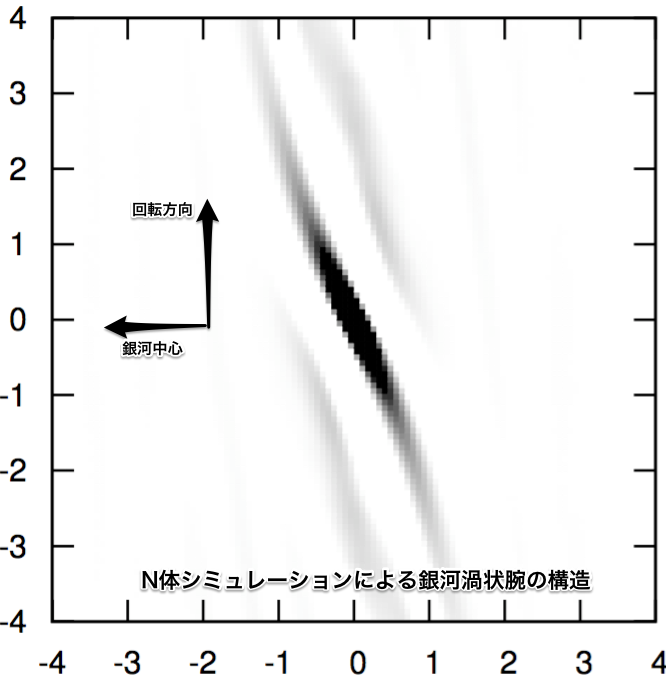
Many galaxies have spiral arms. One of the models to explain the origin of
spiral arms is swing amplification mechanism. Because of the differential
rotation, the spiral arms wind gradually. Then, the self-gravity of the spiral
arms becomes strong relatively. Thus, the amplitude of the spiral arms is
enhanced. This mechanism is called swing amplification. The structures formed
by the swing amplification has not yet been investigated quantitatively.
Therefore using the theoretical analyses and N-body simulations we investigated
the amplitude and the wavelengths of the spiral arms formed by the swing
amplification. We found that the number of spiral arms, the pitch angle, and
the amplitude relate with the velocity shear and the random velocity of the
stars. We expect that we can understand the role of the swing amplification in
the spiral arm formation by comparing with the observations and numerical
simulations.
(2016/3/8)
"Galactic Spiral Arms by Swing Amplification",
Shugo Michikoshi, Eiichiro Kokubo, 2016, Astrophysical Journal, [arXiv]
Shugo Michikoshi, Eiichiro Kokubo
Large-scale structure of magnetic reconnection by means of kinetic simulations

How plasma is accelarated and heated is one of the important issues in space and astro plasma physics. Magnetic reconnection is a promising phenomenon converting the magnetic field energy into plasma kinetic energy. However, the detailed processes are poorly understood. So far, there has been a significant gap between kinetic (micro-scale) model and magnetohydrodynamics (MHD) model, and how both the models are connected is not clear. The present study revealed how the microscopic process is connected to large-scale structure, by means of large-scale kinetic simulations with a state-of-the-art supercomputer. In particular, it is found that the Hall current, which is neglected in the MHD approximation, appears in broad area of the exhaust, implying that the previous MHD models are not always appropriate. The present study points out that the MHD approximation used widely in astronomical simulations is not always valid even for large-scale processes.
(2016/1/24)
"Ion and electron dynamics generating the Hall current in the exhaust far downstream of the reconnection x-line", Keizo Fujimoto and Makoto Takamoto (2016), Physics of Plasmas, 23, 012903
[doi]
Keizo Fujimoto [personal website]
Origin of r-process elements in galactic chemodynamical evolution

The r-process is one of the main processes to synthesize elements heavier than iron. The r-process elements have been observed in metal-poor stars in dwarf galaxies and the Milky-Way halo, but astrophysical site(s) of r-process is not identified yet. Nucleosynthesis calculations suggest that binary neutron star mergers are the promising astrophysical site of r-process. In contrast, galactic chemical evolution studies without considering the formation process of galaxies pointed out that it is difficult to reproduce the observed r-process abundance in extremely metal-poor stars by neutron star mergers due to their long merger time and low occurrence rate. In this study, we performed a series of hydrodynamical simulations of dwarf galaxies assuming that neutron star mergers are the major astrophysical site of r-process. Our simulations reproduce the observed r-process abundance in extremely metal-poor stars by neutron star mergers with merger time of 100 Myr. In addition, we find that the metallicity is constant over ~ 300 Myr from the onset of star formation due to low star formation efficiency in dwarf galaxies. We moreover find that metal mixing in star-forming region avoids producing extremely r-process rich stars, which are inconsistent with the observation, due to the low rate of neutron star mergers. The r-process elements observed in the Milky-Way halo might originate in accreted dwarf galaxies.
(2015/11/24)
"Enrichment of r-process Elements in Dwarf Spheroidal Galaxies in Chemo-dynamical Evolution Model", Yutaka Hirai, Yuhri Ishimaru, Takayuki R. Saitoh, Michiko S. Fujii, Jun Hidaka and Toshitaka Kajino
2015, The Astrophysical Journal, 814, 41
[ADS]
[arXiv]
Yutaka Hirai [personal webpage]
Pitch Angle of Self-Gravity Wakes in Saturn's rings
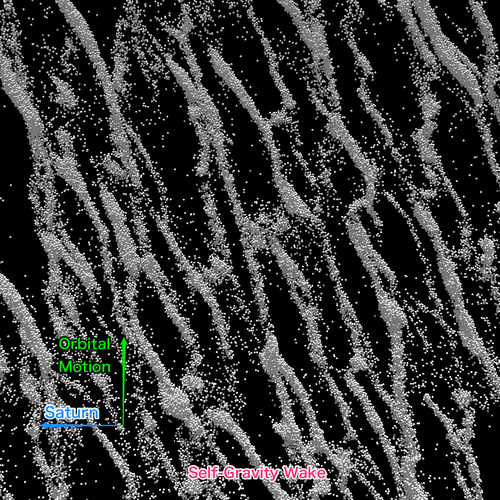
In the main rings of Saturn, small spiral structures called self-gravity wakes
were discovered. They are inclined with respect to the tangential direction.
Observationally it is known that the pitch angle of self-gravity wakes depends
on the Saturnocentric distance. However its dependence has not yet been
understood theoretically. Thus, we performed N-body simulations of
self-gravity wakes and investigated how the properties of the self-gravity
wakes depend on the Saturnocentric distance. We found that the pitch angle
increases with the Saturnocentric distance in A ring. This is consistent with
the observational study. We proposed the simple model and found that the
dependence can be explained by considering the self-gravity and tidal
interactions.
(2015/10/28)
"Dynamics of Self-Gravity Wakes in Dense Planetary Rings I. Pitch Angle",
Shugo Michikoshi, Akihiko Fujii, Eiichiro Kokubo, and Heikki Salo,
Astrophysical Journal, 812, 151
[ADS]
[arXiv]
Shugo Michikoshi, Eiichiro Kokubo
Probing the Stellar Explosions with Presolar Grains
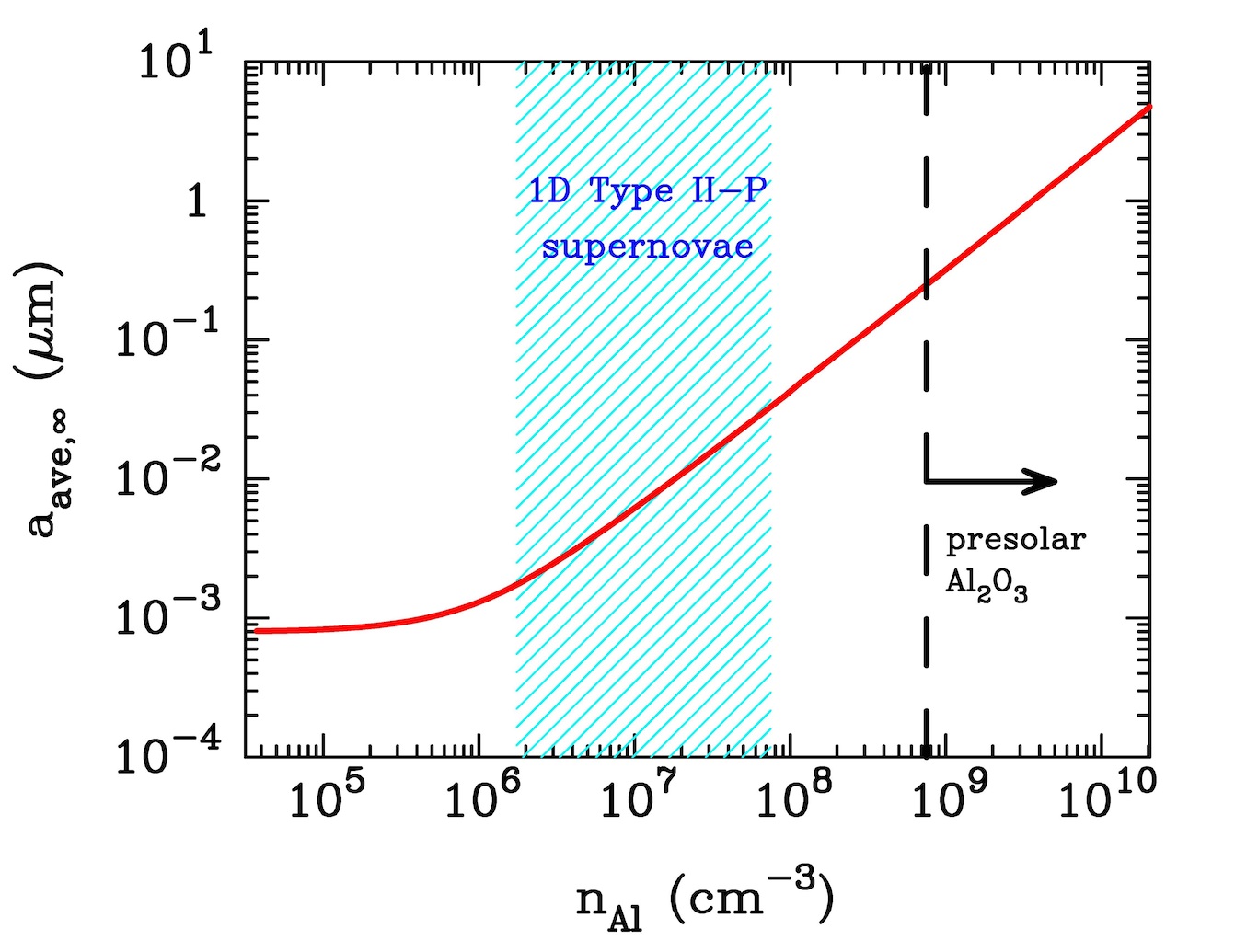
Presolar grains, discovered in meteorites, are tiny solid particles
that
are considered to have been produced before the formation of Solar
System.
A few particles of presolar Al2O3 grains with sizes above 0.5 um are
believed
to have been originated in the ejecta of core-collapse supernovae
(SNe).
With the aim of clarifying the formation condition of such large Al2O3
grains,
we investigate the condensation of Al2O3 grains for wide ranges of the
gas
density and cooling rate.
We find that the formation of submicron-sized Al2O3 grains requires at
least 10 times higher gas densities than those presented by
one-dimensional
SN models.
This indicates that presolar Al2O3 grains might be formed in dense gas
clumps
and that the measured sizes of presolar grains can be a powerful tool
for
constraining the physical conditions of SN ejecta.
The figure plots the calculated average radius of newly formed Al2O3
grains
as a function of number density of Al atoms (red line).
The hatched region depicts the expected ranges of the Al density in
the ejecta,
referring to a one-dimensional model of a Type II-P SN (Kozasa et
al. 2009).
The dashed vertical line denotes the minimum Al density necessary for
explaining the measured sizes (radius of 0.25 um) of presolar Al2O3
grains.
(2015/10/6)
Probing the Physical Condition of Supernova Ejecta with the Measured
Sizes
of Presolar Al2O3 Grains,
by Takaya Nozawa, Shigeru Wakita, Yasuhiro Hasegawa, Takashi Kozasa,
2015, ApJ Letters, 811, L39 (5pp)
[ADS]
[arXiv]
Takaya Nozawa [personal
website]
All sky simulations of gravitational lensing
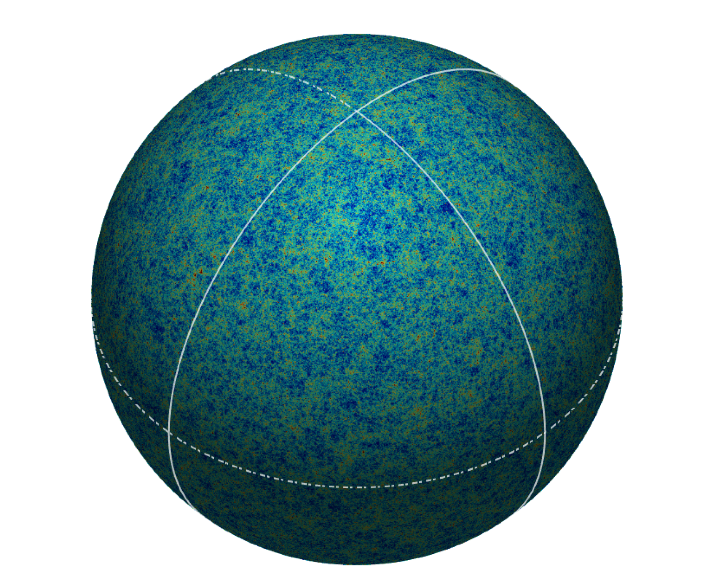
One of our simulated gravitational lensing maps. The red regions represent high surface mass density regions, while the blue regions correspond to underdens regions in the Universe.
Gravitational lensing is one of the most promising tools to probe matter density distribution in the Universe.
The foreground gravitational field causes small image distortion of distant galaxies.
The small distortion contains, collectively, rich cosmological information about the matter distribution.
We can reconstruct the foreground mass distribution from observed image of distant galaxies with statistical analysis.
Ongoing/upcoming imaging surveys such as Hyper Suprime-Cam (HSC) survey in the near future,
will provide the largest dark matter map we have never seen before.
Therefore, it is important and timely to investigate the cosmological information content of the reconstructed mass map.
In order to realize the realistic situation in galaxy imaging surveys,
we perform gravitational lensing simulations on curved full-sky as shown in the figure.
We then utilize these simulations to create two hundreds of mock weak lensing catalogs
with the proposed sky coverage in ongoing HSC survey.
These mock catalogs enable us to study the statistical property of reconstructed mass map
from gravitational lensing obserables.
The detailed comparison with our simulation results and theoretical model of large scale structure
is found in the text.
(2015/9/3)
Probing cosmology with weak lensing selected clusters – I. Halo approach and all-sky simulations , Monthly Notices of the Royal Astronomical Society, 453, 3043-3067
[ADS]
Masato Shirasaki
Polarization Structure of Magnetically Supported Molecular Filaments

Observations of thermal dust emissions with Herschel satellite have revealed that molecular clouds consist of many filaments (Menshchikov et al. 2010). That is, the molecular filaments are the building blocks of interstellar clouds. On the other hand, near IR interstellar polarization indicates the filaments are extending in the perpendicular direction to the interstellar magnetic field (Sugitani et al. 2011).
Magnetohydrostatic equilibrium solutions of isothermal clouds, in which the gravity is balanced with the Lorentz force, thermal pressure and the external pressure, are obtained with a self-consistent field method. We obtained an empirical relation between the maximum supported mass against the self-gravity, λmax(Tomisaka 2014). Here, we studied polarization structures of the thermal dust emissions expected for these filaments.
The polarization of the thermal dust emissions comes from dusts which are aligned to the interstellar magnetic field. In the figure, color and bars represent, respectively, the polarization degree and the direction of polarization (B-vector of the electromagnetic wave). We chose a line-of-sight of θ=80deg and φ=90 deg in the left panel. That is, a filament extending in the z-direction is assumed to be observed from the lateral direction nearly parallel to the large-scale magnetic field. The middle panel corresponds to a low-density filament (center-to-surface density ratio F = 10) and the right one is a high-density filament with F=300.
When we observe the filament from direction of the interstellar magnetic field, we expect extremely low polarization degree since dusts have no special alignment in the plane of sky (middle panel). On the contrary, high-density filaments indicate relatively large polarization degree whose directions are perpendicular to the filament (right panel). This may explain the reason why the perpendicular configuration is often found between the interstellar magnetic field and the filaments.
(2015/5/25)
Polarization Structure of Filamentary Clouds, by Tomisaka, Kohji, 2015, ApJ, in press
[ADS]
[arXiv]
Kohji Tomisaka (private website)
Great Progress towards the Origin of R-process
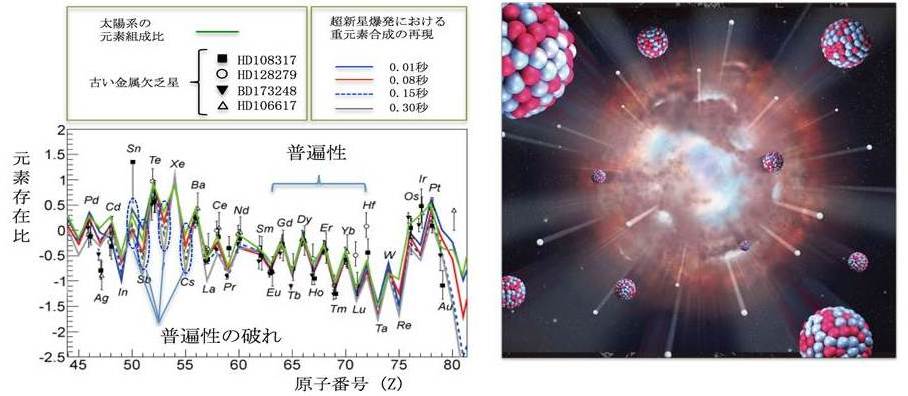
(Left) "Universality" of the elemental-abundance pattern as a function of atomic number Z between the solar-system and the metal-poor halo stars.
(Right) Illustration of r-process nucleosynthesis in core-collapse supernova explosion.
Credit: Akihiro Ikeshita / CG: Masayo Mikami (NAOJ Astronomy Information Center)
Using RIKEN’s Radioactive Isotope Beam Factory, an international research team succeeded in measuring beta-decay half-lives of 110 neutron-rich nuclei, 40 of which were measured for the first time in this measurement. Collaborating with S. Shibagaki and T. Kajino (University of Tokyo/National Astronomical Observatory of Japan), they carried out theoretical calculations of r-process nucleosynthesis with the newly measured half-lives. Their results expected from core-collapse supernova scenario are consistent with observed elemental abundances in the solar system and metal-poor stars.
Please visit following websites for more detail.
RIKEN press release
NAOJ
(2015/05/14)
β-Decay Half-lives of 110 Neutron-Rich Nuclei across the N = 82 Shell Gap: Implications for the Mechanism and Universality of the Astrophysical r-process
G. Lorusso, et al., Phys. Rev. Lett. 114.192501
Shota Shibagaki and Toshitaka Kajino (personal website)
Loading relativistic velocity distributions in particle simulations

In particle-in-cell (PIC) simulations and Monte-Carlo simulations, particle velocities are initialized by using random variables. However, algorithms to generate relativistically-moving distributions are not well established. This article proposes rejection methods for full Lorentz transformation of arbitrary distribution functions.
(2015/05/07)
Seiji Zenitani, Phys. Plasmas 22, 042116 (2015).
[Journal]
[arXiv]
Seiji Zenitani (personal website)
The initial mass function of star clusters
Star clusters form in molecular clouds, and their mass distributes from several tens to a few tens of thousands solar masses. The observed mass function of star clusters is known to have a power-law slope of -2, but the origin of the power-law index is still unclear. In turbulent molecular clouds, stars and star clusters form along the filamentary structures. We developed a new scheme, in which the hydrodynamical and N-body simulations are divided, in order to simulate the formation of a bunch of star clusters. In our simulation a few tens of star clusters formed from an each molecular cloud, and we found that the cluster mass function that originates from an individual molecular cloud is written by a Schechter function with a power-law slope of -1.73 at 2 Myr and -1.67 at 10 Myr, which fits to observed cluster mass function of the Carina region. The superposition of mass functions have a power-law slope of around -2, which fits the observed mass function of star clusters in the Milky Way, M31 and M83.
(2014/4/23)
Michiko Fujii and Simon Portegies Zwart, Monthly Notices of the Royal Astronomical Society, 449, 726-740
[ADS]
Michiko Fujii [personal webpage]
Quantum theoretic approach to in-medium effects on the neutrino scattering
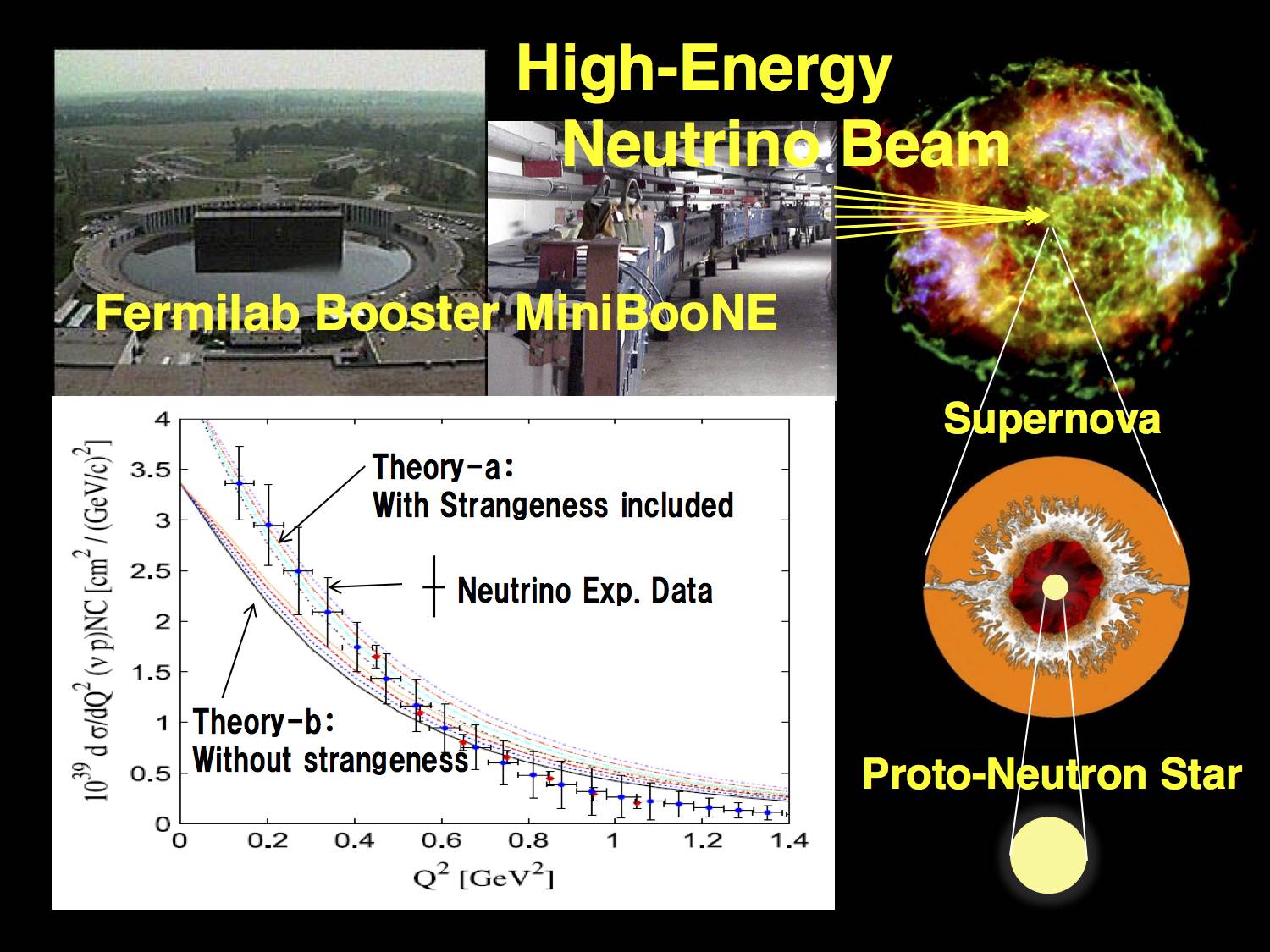
Neutrino scattering provides a unique signal for understanding the weak interaction processes in an extremely high-temperature and high-density matter inside the proto-neutron stars born in core-collapse supernova explosions. COSNAP* international collaboration group conducted by Prof. M.-K. Cheoun (Soongsil Univ./NAOJ) and Prof. T. Kajino (NAOJ/Univ. of Tokyo) carried out a quantum mechanical calculation of the neutrino scattering cross sections on nucleons and nuclei at E < 100 GeV in the quark meson coupling (QMC) model and compared the theoretical result with neutrino data detected at high-energy particle accelerators MiniBooNE and NOMAD. It is found that below 1 GeV at energies relevant for applications to the neutrino processes in the supernova matter, one needs to include nucleonic form factor and nuclear structure effects as well as the Fermi motion of nucleons.
The paper is selected as a highlight of Journal of Physics G and has been taken in labtalk-article (http://iopscience.iop.org/0954-3899/labtalk-article/59987) entitled "When and how do we include the in-medium effects in neutrino scattering off target nuclei?". In this article both laboratories, Prof. Cheoun's Labo and Prof. Kajino's COSNAP* Labo, are introduced as active theory groups that continuously produce high-quality science papers.
This shows a schematic image that the high-energy neutrino beams from accelerators like Fermilab MiniBooNE are unique experimental tools to study the neutrino processes inside the proto-neutron stars born in core-collapse supernova explosions. The inset Figure shows that the degrees of freedom of strangeness make the important effects on the neutrino scattering cross sections. (Photograph are taken from http://www-boone.fnal.gov/virtual_tour/.)
M.-K. Cheoun, K.-S. Kim, H.-C. Kim, W.-Y. So, T. Maruyama and T. Kajino,
J. Phys. G42 (2015) 045102.
[http://iopscience.iop.org/0954-3899/42/4/045102/article]]
*COSNAP: COSmology and Nuclear AstroPhysics theory group
T. Kajino (http://th.nao.ac.jp/MEMBER/kajino/)
(2015/04/09)
FY 2014
Shocking structure in a supersonic reconnection jet
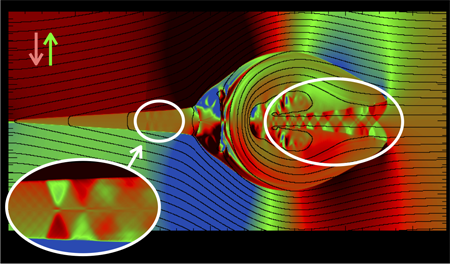
Shock diamonds appear in a jet, when the jet supersonically emanates from the nozzle.
They are one of the most beautiful examples of high-speed fluid dynamics.
A cyclic structure within a cosmic jet is also attributed to shock-diamonds.
Magnetic reconnection releases a fast outflow jet from the reconnection site.
When the jet speed exceeds that of the sound, shock-diamonds similarly appear.
Our high-resolution magnetohydrodynamic (MHD) simulation
reveals multiple shock-diamonds in a reconnection system.
In the figure, the triangles indicate
the plasma vertical motion associated with shock-diamonds.
We recognize
under-expanded shock-diamonds inside the reconnection jet (the left circle) and
over-expanded shock-diamonds ahead of the magnetic island (the right circle).
High-speed fluid dynamics (also known as compressible fluid dynamics)
will be important in our future research,
because astrophysical MHD systems often involve violent supersonic flows.
(2015/03/27)
Seiji Zenitani, Phys. Plasmas, 22, 032114
[Journal]
[arXiv]
Seiji Zenitani (personal website)
Stochastic electron acceleration during spontaneous turbulent reconnection in a strong shock wave
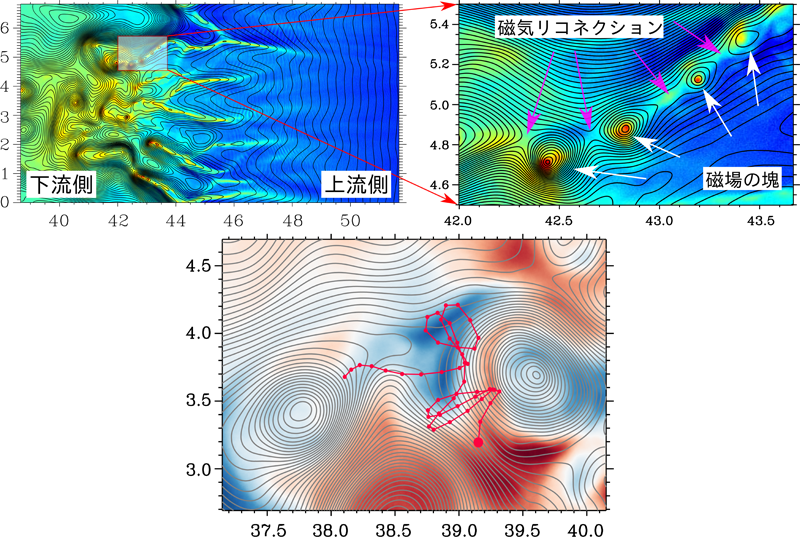
Explosive phenomena such as supernova remnant shocks and solar flares have demonstrated evidence for the production of relativistic particles. Interest has therefore been renewed in collisionless shock waves and magnetic reconnection as a means to achieve such energies. Although ions can be energized during such phenomena, the relativistic energy of the electrons remains a puzzle for theory. We present supercomputer simulations showing that efficient electron energization can occur during turbulent magnetic reconnection arising from a strong collisionless shock. Upstream electrons undergo first-order Fermi acceleration by colliding with reconnection jets and magnetic islands, giving rise to a nonthermal relativistic population downstream. These results shed new light on magnetic reconnection as an agent of energy dissipation and particle acceleration in strong shock waves.
(2015/02/27)
“Stochastic electron acceleration during spontaneous turbulent reconnection in a strong shock wave” by
Y. Matsumoto, T. Amano, T. N. Kato, M. Hoshino, 2015, Science, Vol. 347 no. 6225 pp. 974-978
Tsunehiko Kato [personal
website]
Revealing Large Amounts of Dust and Unusual Extinction
Curves in the Early Unvierse
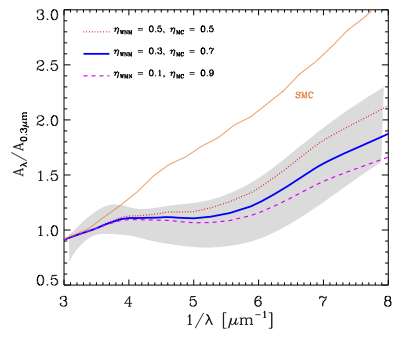
There are many pieces of evidence that the extinction curves of quasars at redshifts above z=5 are different from those at low-z quasars and that a huge amount of dust is present in their host galaxies. These indicate that the early interstellar medium was rapidly enriched with dust grains, whose properties are quite unusual.
We investigate the evolutions of dust content and extinction curve in a high-z quasar, based on the state-of-the-art dust evolution model that takes account of grain size distribution. We show that the massive amounts of dust and the peculier extinction curves in high-z quasars can be naturally explained if a large fraction of the interstellar medium is in dense molecular-cloud phases, where efficient grain growth and coagulation occur. We also find that the major composition of carbonaceous dust in high-z dusty galaxies is amorphous carbon rather than graphite. These results indicate the differences in the properties of dust and in the condition of the interstellar medium between low-z and high-z galaxies.
The figure shows calculated UV extinction curves at t = 1 Gyr. The dotted, thick solid, and dashed lines show the results for the mass fraction of the molecular-cloud phase, 0.5, 0.7, and 0.9, respectively. The hatched region is the range of the extinction curve for the high-z quasar J1048+4637 at z = 6.2 (Maiolino et al. 2004). For comparison, the SMC extinction curve is drawn by the thin solid line.
(2014/12/9)
Evolution of grain size distribution in high-redshift dusty quasars:
integrating large amounts of dust and unusual extinction curves by
Takaya
Nozawa, Ryosuke S. Asano, Hiroyuki Hirashita, Tsutomu T. Takeuchi,
2015,
MNRAS Letters, 447, L16-L20
[ADS]
[arXiv]
Takaya Nozawa([personal
website])
The world’s most extensive simulation of the Milky Way galaxy
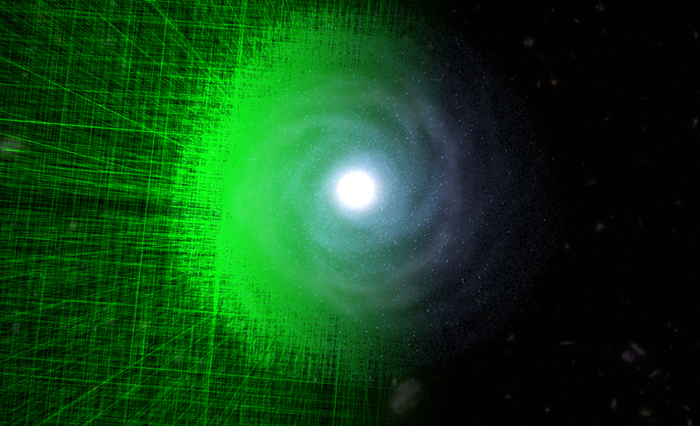
An international research team including Jeroen Bédorf, Simon Portegies Zwart (Leiden University, the Netherlands), Michiko Fujii (NAOJ, Japan) and others developed a new application “Bonsai” for numerical simulations of galaxies. Using this, they performed the world’s most extensive simulation of the Milky Way galaxy using 18600 GPUs. Around 240 billion particles are used in this simulation, and it provides detailed enough data for direct comparison to the observed stars in the Milky Way. In addition, the simulation achieved a computational speed of 24.77 Pflops (Peta Floating-point Operations Per Second), which is currently the world record. Because of these results, the research team is one of five finalists nominated for this year’s Gordon Bell Prize.
Please visit here for more detail.
(2014/12/16)
“24.77 Pflops on a Gravitational Tree-Code to Simulate the Milky Way Galaxy with 18600 GPUs” by
Jeroen Bédorf, Evghenii Gaburov, Michiko S. Fujii, Keigo Nitadori, Tomoaki Ishiyama, Simon Portegies Zwart, 2014, MACM/IEEE conference on Supercomputing (SC14), New Orleans, Louisiana, USA, Nov. 2014
Michiko Fujii([personal
website])
Discovery of a Blue Star at the Location of Supernova 2011dh
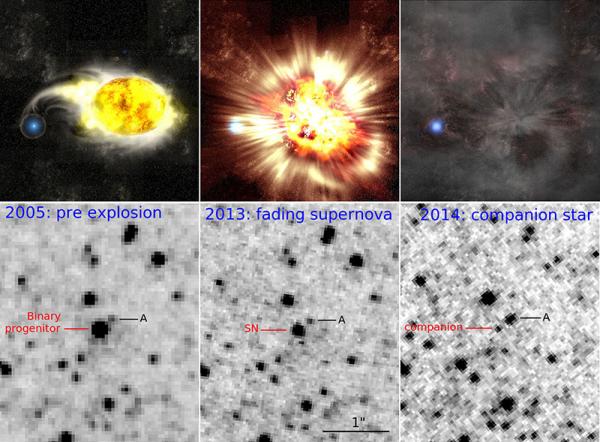
An International research team, including Kavli IPMU, University of La Plata, Kyoto University, NAOJ, and so on, discovered a blue (massive) star at the position of Supernova 2011dh about three years after the explosion with the Hubble Space telescope. The detection of this blue star verified the theoretical prediction
that the progenitor star of SN 2011dh had been paired with a massive companion star. This discovery will largely advance the understanding of the connection
between the binary evolution and supernova explosions.
Please see [the website of Kavli IPMU] for more details.
(Credit -- Top image: Kavli IPMU, Bottom image: NASA/Kavli IPMU/Gaston Folatelli)
(2014/9/19)
A Blue Point Source at the Location of Supernova 2011dh,
by Gaston Folatelli, et al., 2014, ApJ Letters, 793, L22 (5pp)
[ADS]
[arXiv]
Takaya Nozawa [personal website]
Cosmological solutions to the Lithium problem:
Big-bang nucleosynthesis with photon cooling,
X-particle decay and a primordial magnetic field
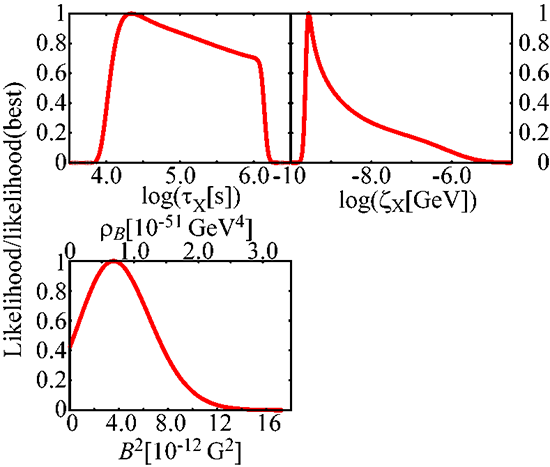
The 7Li abundance calculated in BBN with the baryon-to-photon ratio fixed from fits to the CMB power spectrum is inconsistent with the observed lithium abundances on the surface of metal-poor halo stars. Previous cosmological solutions proposed to resolve this 7Li problem include photon cooling (possibly via the Bose-Einstein condensation of a scalar particle) or the decay of a long-lived X-particle (possibly the next-to-lightest supersymmetric particle).
In this paper, A theory group of Dr. Yamazaki, Dr. Kusakabe, Prof. Kajino, Prof. Mathwes, and Prof. Cheoun reanalyze these solutions, both separately and in concert. They also introduce the possibility of a primordial magnetic field (PMF) into these models. They constrain the X-particles and the PMF parameters by the observed light element abundances using a likelihood analysis to show that the inclusion of all three possibilities leads to an optimum solution to the lithium problem. They deduce allowed ranges for the X-particle parameters and energy density in the PMF that can solve 7Li problem.
(2014/07/03)
Cosmological solutions to the Lithium problem:
Big-bang nucleosynthesis with photon cooling,
X-particle decay and a primordial magnetic field
Phys. Rev. D 90, 023001
[ADS]
[arXiv]
Please visit here for more detail.
Dai G. Yamazaki (private website)
Formation of Carbon Grains in Very Massive Primordial
Stars
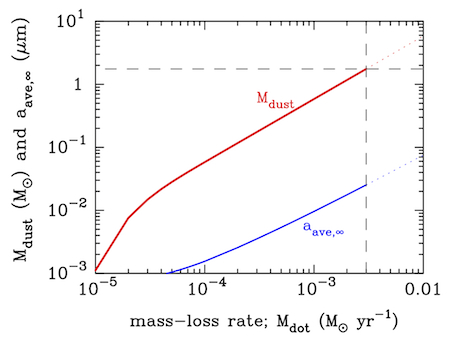
Since the beginning of this century, the presense of huge amounts of dust grains has been confirmed at the times around one tenth of the present cosmic age. Since then, the origin of cosmic dust in the early universe has been hotly debated.
We investigate the formation of dust in a stellar wind during the red-supergiant phase of a very massive first star with the zero-age main sequence mass of 500 times the solar mass. We find that, such a very massive star can produce, at most, one solar mass (300000 times the earth mass) of carbon grains in total during its lifetime. This indicates that, if the first stars are very massive as suggested by many studies, then they can be the first important sources of small solid particles in the universe.
The figure plots the total mass of carbon grains formed during the evolution of a very massive first star whose initial mass is 500 times solar mass, as a function of mass ejection rate. The figure shows that, for the mass ejection rate of 0.003 solar mass per year, 1.7 times solar mass of carbon grains can form in total with the average radius around 0.02 um.
(2014/5/30)
Dust Production Factories in the Early Universe: Formation of Carbon
Grains in Red-Supergiant Winds of Very Massive Population III Stars,
by Takaya Nozawa, et al., 2014, ApJ Letters, 787, L17 (5pp)
[ADS]
[arXiv]
Takaya Nozawa
A New Production Mechanism for Ultra-High-Eneregy Cosmic Ray (UHECR) Neutrinos
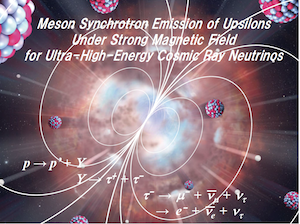
T. Kajino, A. Tiokuhisa at NAOJ and The University of Tokyo and their international collaboration team have recently proposed a new theory for UHECR tau-neutrinos that could keep ultra-high energy > 10^15 eV. Although two neutrino events, whose energies are higher than 10^15 eV, were detected in IceCube Neutrino Observatory last year, origin of the UHECR is still an unanswered biggest mystery of the century. Although Ginzburg & Syrovatskii (1965) and Waxman & Bahcall (1997) theoretically proposed a model to produce neutral mesons pi, D_s, J/ψ as the source of high-energy neutrinos, they easily lose energy during the passage in space for relatively longer life, and neutrino energy cannot be as high as 10^15 eV. Kajino and his collaborators discovered that the strong interaction between UHECR hadrons like protons or irons can copiously produce heavy neutral mesons like upsilons in synchrotron emission near the strongly magnetized neutron star (i.e. magnetar) or active galactic nuclei (AGN), which quickly decay to produce tau-lepton pairs and create eventually UHECR tau-neutrinos.
(2014/05/09)
T. Kajino, A. Tokuhisa, G. J. Mathews, T. Yoshida & M. A. Famiano., ApJ. 782 (2014), 70.
[ADS]
T.Kajino(personal website)
FY 2013
New constraints on primordial magnetic fields from the
CMB
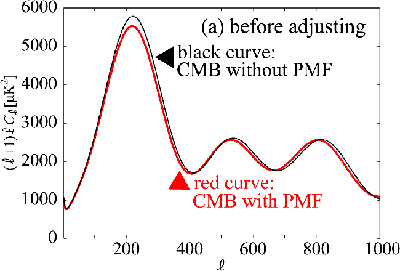
Dai G. Yamazaki (Division of Theoretical Astronomy, National Astronomical
Observatory of Japan)
investigates the effects of the background PMF on the CMB. The sound speed
of the tightly coupled photon-baryon fluid is increased by the background
PMF. The increased sound speed causes the odd peaks of the CMB temperature
fluctuations to be suppressed, and the CMB peak positions to be shifted to
larger scale. The background PMF causes the stronger decaying potential, and
increases the amplitude of the CMB. These two effects of the background PMF
on a smaller scale cancel out, and the overall effects of the background PMF
are suppression of the CMB around the first peak and shifting peaks to large
scale. We also discuss obtaining information about the PMF generation
mechanisms, and examine the non-linear evolution of the PMF by the
constraint on the maximum scale for the PMF distributions. Finally, he
discusses degeneracies between the PMF parameters and the standard
cosmological parameters.
*This work was accepted for publication as a Regular Article in Physical
Review D on March 31 2014.
CMB with the background primordial magnetic field
Dai G. Yamazaki, Accepted 31 March 2014
Please visit here for more detail.
Dai G. Yamazaki (private
website)
Some remarks on the diffusion regions in magnetic reconnection
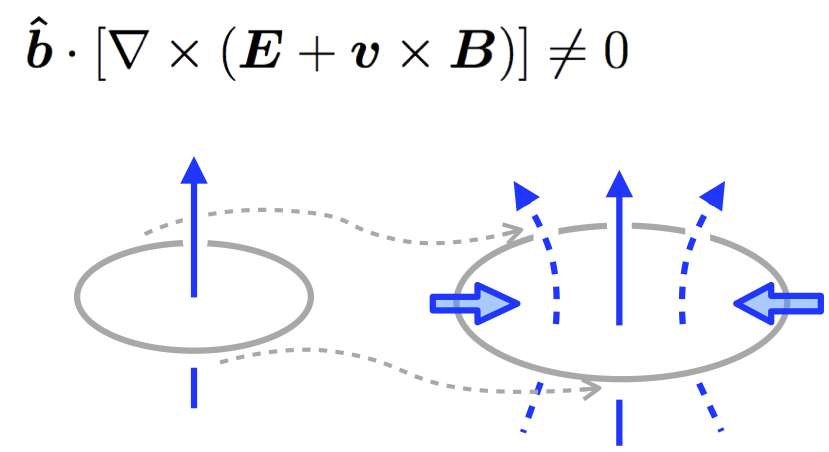
The so-called "diffusion region" near the magnetic reconnection point is very important in reconnection physics. However, the structure of the diffusion regions is very puzzling in a kinetic plasma.
In this article, we study the structure of the diffusion region in kinetic reconnection, by reconsidering the notion of magnetic diffusion. We interpret that the the magnetic diffusion is a relaxation process to the frozen-in state, and then we propose the field-aligned component of the frozen-in condition to evaluate a diffusion-like process (See Figure). By using a Vlasov simulation, we confirm diffusion signatures near the reconnection site.
This research extends the notion of the magnetic diffusion to a kinetic plasma. It also provides a hint to another important problem --- the relevance between the magnetic diffusion and the disconnection of magnetic field lines, i.e., magnetic reconnection.
(2014/03/31)
Seiji Zenitani and Takayuki Umeda,
Phys. Plasmas, 21, 034503
[Journal]
[arXiv]
Seiji Zenitani (personal website)
Structure of Magnetized Molecular Filaments
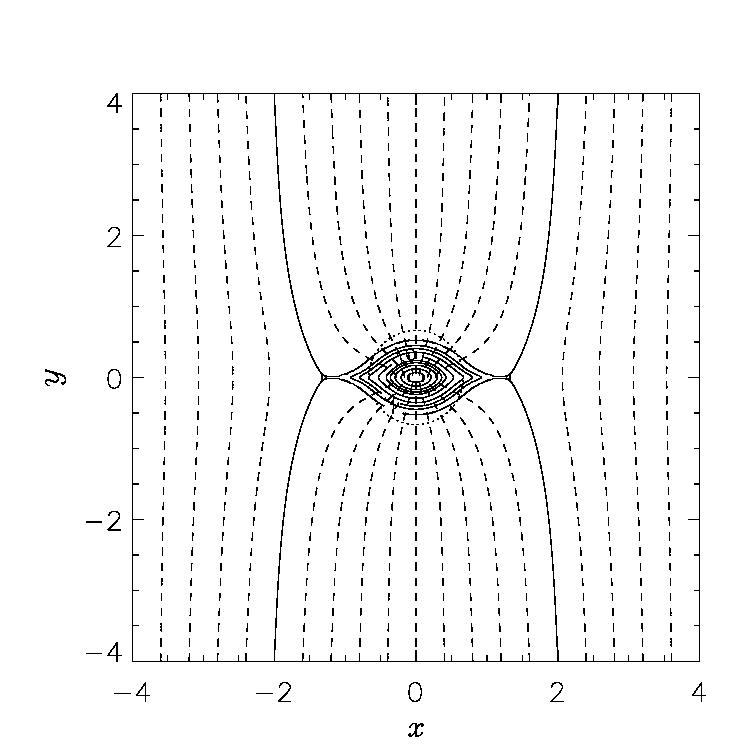
Observations of thermal dust emissions with Herschel satellite
have revealed that molecular clouds consist of
many filaments.
That is, the molecular filaments are the building blocks of interstellar
clouds.
On the other hand, near IR interstellar polarization indicates
the filaments are extending in the perpendicular direction to
the interstellar magnetic field.
In this article, equilibrium solutions of isothermal clouds are
obtained with a self-consistent field method.
The figure shows a typical solution of cross section of these filaments.
Dashed and closed solid curves represent, respectively,
magnetic field lines and isodensity contour lines.
From calculated 118 models, we obtained an empirical formula expressing
the maximum supported mass against the self-gravity (critical mass).
It is shown that the critical mass is proportional
to the magnetic flux threading the filament.
The importance of this article is that structure and the maximum mass
of the building block of molecular clouds are first determined theoretically.
(2014/3/17)
Magnetohydrostatic Equilibrium Structure and Mass of Filamentary Isothermal Cloud Threaded by Lateral Magnetic Field, by Tomisaka, Kohji, 2014, ApJ, 785, 24 (12pp)
[ADS]
[arXiv]
Kohji Tomisaka (personal website)
The moment of core collapse in star clusters with a mass function
Core-collapse time is an important timescale to understand the dynamical evolution of star clusters. While the evolution of single-component models is theoretically understood well, more realistic models with stellar mass functions is not yet. We performed a series of N-body simulations of star clusters with mass functions, and we numerically and analytically showed that the dynamical evolution of star clusters with mass functions is driven by the most massive stars and as a result the core-collapse time is anti-correlated with the mass of the most massive stars in the cluster. Clusters with mass functions effectively behave as small-N systems composed of massive stars. When the mass of the most massive star in a cluster is comparable to the core mass, the cluster does not show significant density increase. This type of evolution would be common for young clusters harboring massive stars.
Movie: Evolution of a star cluster with a mass function
Red: 100 times more massive than the mean mass, orange: 10-100 times, yellow: 2-10 times, green: 1-2 times, blue less massive than the mean mass.
While massive stars sink to the cluster center due to the dynamical friction, light stars move to the outskirts. A binary from at T=10, and then it kicks the surrounding stars out of the cluster.
(2014/3/17)
Michiko Fujii and Simon Portegies Zwart, Monthly Notices of the Royal Astronomical Society, 2013, 439, 1003
[ADS]
Michiko Fujii [personal webpage]
A New Theoretical Method to determine the Unknown Neutrino Mass-Hierarchy
-- Selected as A Highlight Topical Review of 2013 in Journal of Physics G --
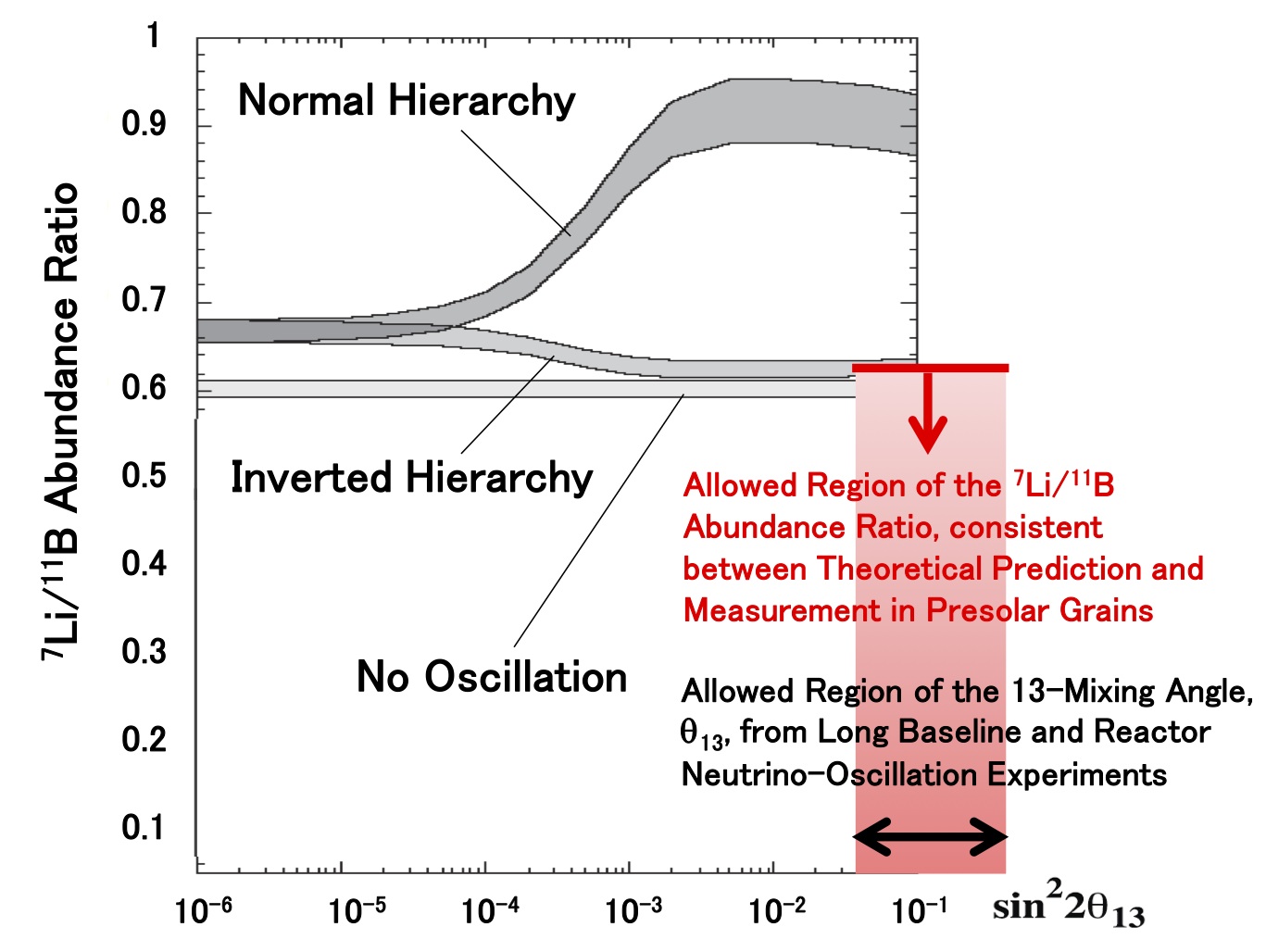
Three flavors of active (electron-, mu- and tau-type) neutrinos are known to have finite masses and show the oscillation phenomena during their passage through space or matter inside the sun and supernovae (SNe). It is one of the ultimate purposes in modern physics and cosmology to determine their masses and oscillation properties to construct a unified theory of elementary particles and fields beyond the standard model because neutrino mass is the unique experimental evidence which indicates the breakdown of the standard model. There are still two unknown parameters, i.e. the mass hierarchy (normal or inverted) and the CP violation phase. Toshio Suzuki (Nihon University/NAOJ) and Toshitaka Kajino (NAOJ) have proposed an astronomical method to determine the mass hierarchy in terms of SN nucleosynthesis of specific elements that were produced by the energetic neutrinos interacting with abundant nuclei inside the SNe under the MSW effects of neutrino oscillation. They also prove theoretically that the proposed method is robust almost independent of the Hamiltonians assumed in the theoretical calculations of quantum neutrino-nucleus interaction cross-sections. This paper was selected as a highlight topical review of 2013 in Journal of Physics G.
In the figure it is shown that the inverted mass hierarchy is statistically more preferred from the comparison of the Li7/B11 abundance ratio between theoretical prediction and observation from presolar grains which originate from SNe ejecta.
(2014.02.12)
T. Suzuki and T. Kajino, J. Phys. G40 (2013), 083101.
IOP science
http://th.nao.ac.jp/MEMBER/kajino/
New constraints on primordial magnetic fields from the
CMB
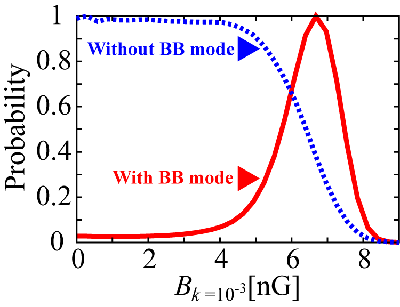
Dai G. Yamazaki (Division of Theoretical Astronomy, National Astronomical
Observatory of Japan) has released a new constraints on the multi-lognormal
magnetic fields from the observations of the cosmic microwave background and
the matter power spectrum.
(2013/11/11)
Please visit here for more detail.
Dai G. Yamazaki (private website)
Stringent Constraint on the 4th Flavor-Generation of Neutrino from Big-Bang Nucleosynthesis
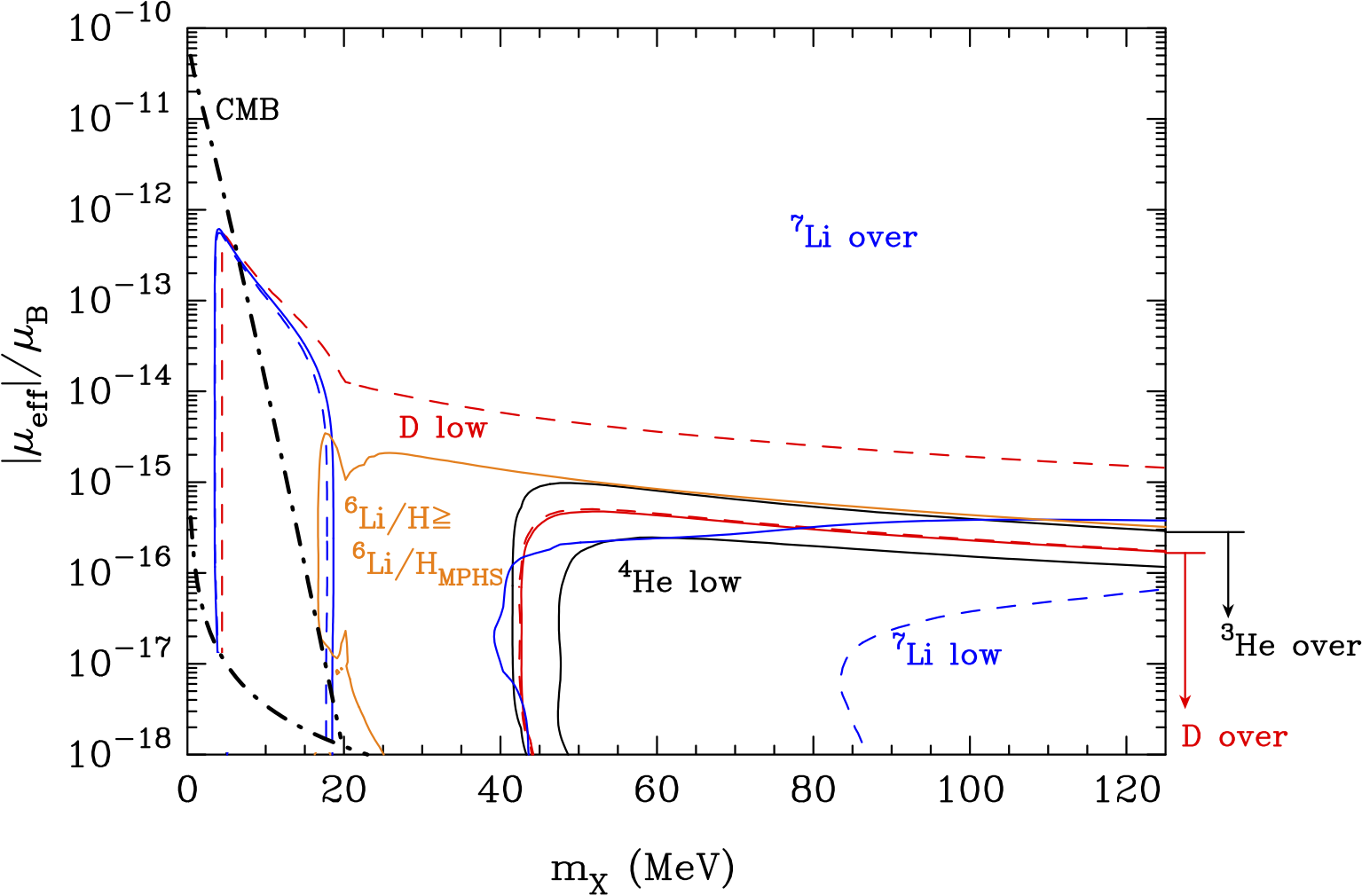
There are three flavor generations of active neutrinos, i.e. electron-, mu- and tau-type neutrinos, in the standard model of elementary particles and fields. Recent observations of cosmic microwave background (CMB) anisotropies and high-energy neutrino oscillation experiments have suggested a piece of evidence for the 4th generation of neutrino which is called "sterile neutrino". A theory group of Motohiko Kusakabe, Toshitaka Kajino, Baha Balantekin and Yamac Pehlivan found that the non-thermal photons produced in the decay of massive, sterile neutrinos with finite magnetic moment can make a remarkable effect on the Big-Bang nucleosynthesis (BBN) of the light elements. Taking account of simultaneous constraint of non-thermal photons on CMB anisotropies, they succeeded in constraining the mass and magnetic moment which give rise to a mean life of sterile neutrino, thus making direct influence on the BBN.
In the figure thin vertical region near m_X = 5 MeV between the blue solid and red dashed lines is allowed on the two parameter plane, the mass vs. magnetic moment of sterile neutrino. Only upper limit on the magnetic moment has been known in literatures of reactor neutrino experiments and theoretical studies of the cooling rate of red giant stars.
(2013/11/01)
Kusakabe, M.,et al. 2013, Phys. Rev. D87, 085045.
http://th.nao.ac.jp/MEMBER/kajino/
The seeds of planets are fluffy

A Japanese research team led by Akimasa Kataoka (SOKENDAI / Theoretical Division of National Astronomical Observatory of Japan) has released a new scenario of planetesimal formation from micron-sized dust grains to 10 kilometer-sized planetesimals.
Please visit here for more detail.
Ion nonlinear dynamics in magnetic reconnection
We study basic properties of collisionless magnetic reconnection in space- and astroplasmas, by means of fully kinetic simulations. In this work, we examine an ion velocity distribution function (VDF) at the center of a reconnection outflow exhaust. We find that (1) the particle orbit theory can be applied to the VDF, (2) nongyrotropic ion motion results in the violation of the ideal MHD condition (E+VxB≠0), and (3) some ions travel through regular orbits in the chaotic particle dynamics. These results shed light on the approach of the nonlinear dynamics in modern plasma physics. The movie presents a Poincare map that visually classifies particle orbits. Enjoy how it looks like!
(2013/09/03)
Seiji Zenitani, Iku Shinohara, Tsugunobu Nagai, and Tomohide Wada,
Phys. Plasmas, in press
[ADS]
[arXiv]
Seiji Zenitani (private website)
Optical/Infrared Emission from Neutron Star Merger
Next-generation gravitational-wave (GW) detectors, such as KAGRA, are expected to detect GWs from neutron star (NS) mergers. To study the nature of the GW sources, it is extremely important to identify electromagnetic wave counterparts. In this paper, we have succeeded in radiative transfer simulations of NS merger ejecta including detailed r-process elements for the first time. We showed that the optical/infrared emission is fainter than previously expected by a factor of 10, but that the emission is, in fact, detectable with 4-8m class telescopes. Based on this result, we can determine the observational strategy following the GW detection. This result is one of the first steps toward new astronomy using GWs and electromagnetic waves. (The movie shows photon intensity in the NS merger ejecta)
(2013/8/27)
Masaomi Tanaka and Kenta Hotokezaka, Astrophysical Journal, 775, 113
[ADS]
Masaomi Tanaka [personal webpage]
Growth of Rayleigh-Taylor and Richtmyer-Meshkov Instabilities in Relativistic Jets
The relativistic jet propagating through the ambient medium is subjected to a storm of instabilities. The shear layer, which develops spontaneously at the interface between the jet and the surrounding medium, can be destabilized by the Kelvin-Helmholtz instability (Ferrari et al.1978). In this study, the stability of the transverse structure of the relativistic jet was studied using two-dimensional special relativistic hydrodynamic simulations. An intriguing finding in our study is that Rayleigh-Taylor and Richtmyer-Meshkov type instabilities can destroy cylindrical jet configuration as a result of the induced radial oscillating motion. Shown in the above animation is the temporal evolution of the transverse structure of the jet with a normal jet velocity. Color contours represent the spatial distribution of the effective inertia in the jet-external medium system.
(2013/7/2)
Jin Matsumoto and Youhei Masada 2013 ApJ 772 L1
[link]
[arXiv]
Early Galactic Chemical Evolution and r-Process Nucleosynthesis in Black-Hole forming Supernovae
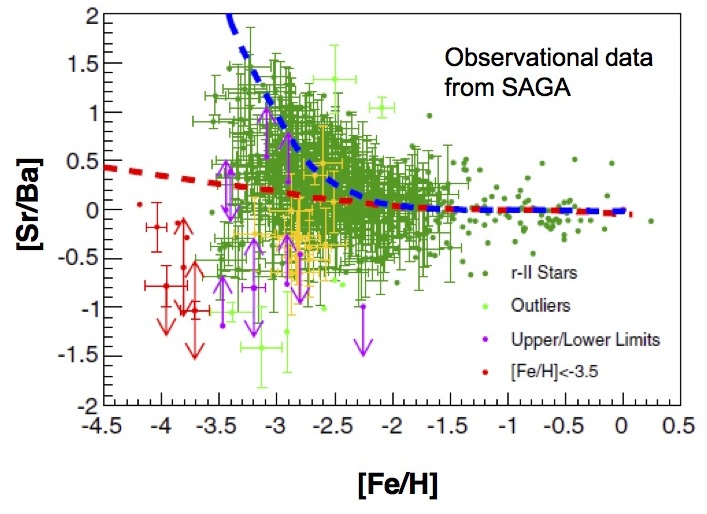
Subaru-HDS team discovered that the universality in heavy r-process elements for extremely metal-poor (EMP) halo stars is progressively broken as the metallicity decreases for -3.5 < [Fe/H] < -2.0 (Aoki et al. 2005, ApJ, 632, 611). We proposed a model (Boyd et al., 2011, ApJ 744, L14) which can explain the enhanced production of light r-process element like Sr relative to Ba in truncated r-process in core-collapse supernovae (SNe), that is, by the collapses to black holes over a fairly wide mass range of progenitor stars. However, a huge dispersion in [Sr/Ba] by more than three order of magnitude is still an unresolved problem. NAOJ collaboration team of observational astronomers and theoretical astrophysicists has recently proposed a solution to this problem so that the effects of turbulent mixing of explosive SN ejecta are found to be important in explaining the large scatter observed in the [Sr/Ba] data. The paper has been published in ApJ Lett.
(2013/06/17)
Aoki, W., Suda, T., Boyd, R.N., Kajino, T., Famiano 2013, M.A., ApJ 766, L13.
[link]
http://th.nao.ac.jp/MEMBER/kajino/
Static compression of porous dust aggregates
Selected to A&A highlighted papers in A&A Vol. 554 (June 2013)
Understanding the structure and growth of ice particles in circumstellar disks is key to analyze observations of these disks and infer consequences for planet formation. Grains had been considered spherical and compact, with a density equal to that of ice, i.e. about 1 g/cc, until recent work pointed out that growth tends to form very fluffy aggregates with densities as low as 0.00001 g/cc and planetesimals sizes. However no such objects has been observed today and it is thus critical to understand how we can transform fluffy aggregates into relatively dense planetesimals. This work is a first step in that direction: Using numerical experiments we derive a relation between the pressure that is applied to the aggregates (e.g. due to gas drag in the disk) and their filling factor (i.e. their physical density). This relation will be crucial to understand the history of the evolution of grains and planetesimals in disks.
(2013/3/15)
Kataoka, et al. 2013, A&A 554, A4
[link]
Akimasa Kataoka (private website)
Solution to the Lithium Problem in Big-Bang Nucleosynthesis in Hybrid Axion Dark Matter Model
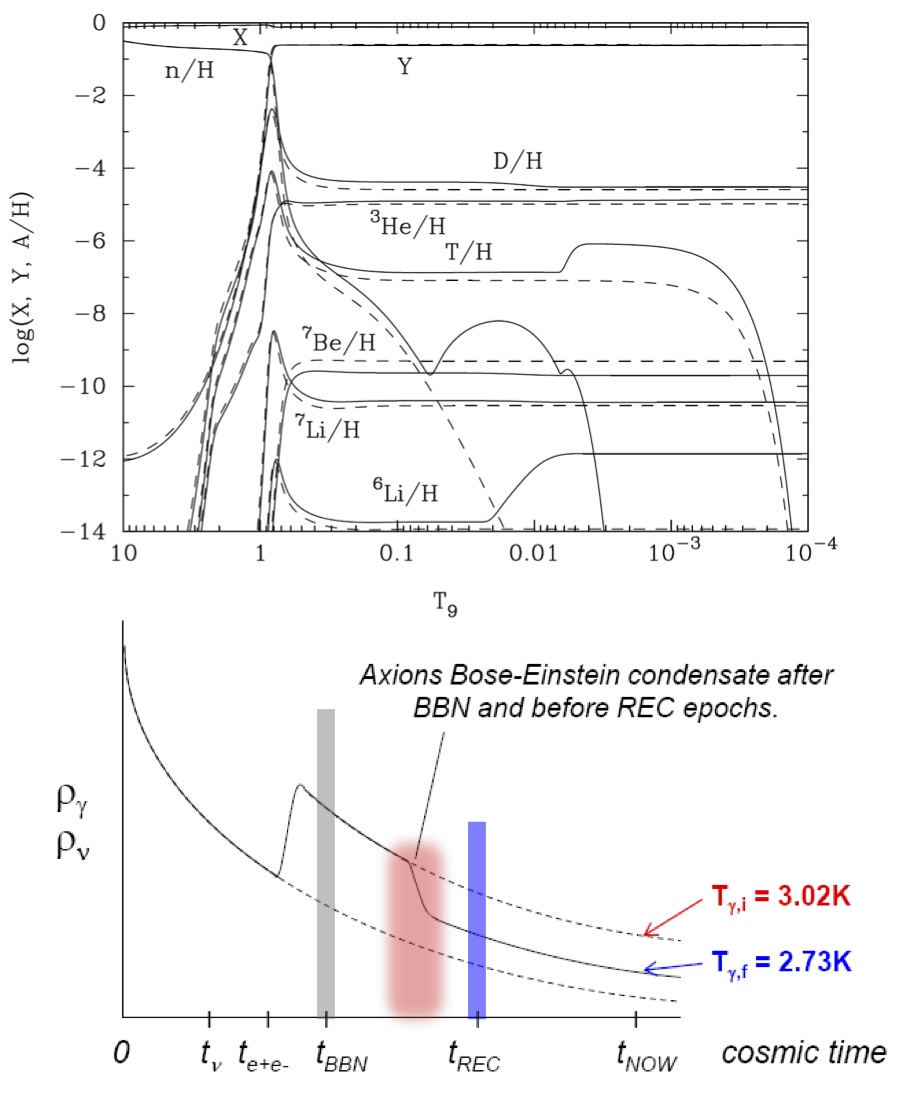
The primordial Li7 abundance predicted in standard big-bang nucleosynthesis (SBBN) model for the baryon-to-photon number ratio determined from the CMB anisotropies is significantly more than those observed in metal-deficient old halo stars. Recent observations of these stars have also suggested that Li6 abundance seems to be larger than SBBN prediction by three orders of magnitude, which casts a serious doubt on the validity of the cosmological model for SBBN. Kusakabe, Kajino and their collaborators have recently proposed a new hybrid BBN model including both axions and relic supersymmetric particles as dark matter that explains both Li7 and Li6 abundances consistent with observations without destroying the important concordance of deuterium abundance.
(2013/05/11)
Kusakabe, M. et al. 2013, Phys. Lett. B718, 704-708.
Science Direct
http://th.nao.ac.jp/MEMBER/kajino/
FY 2012
3-D Observations of the Outflow from an Active Galactic Nucleus
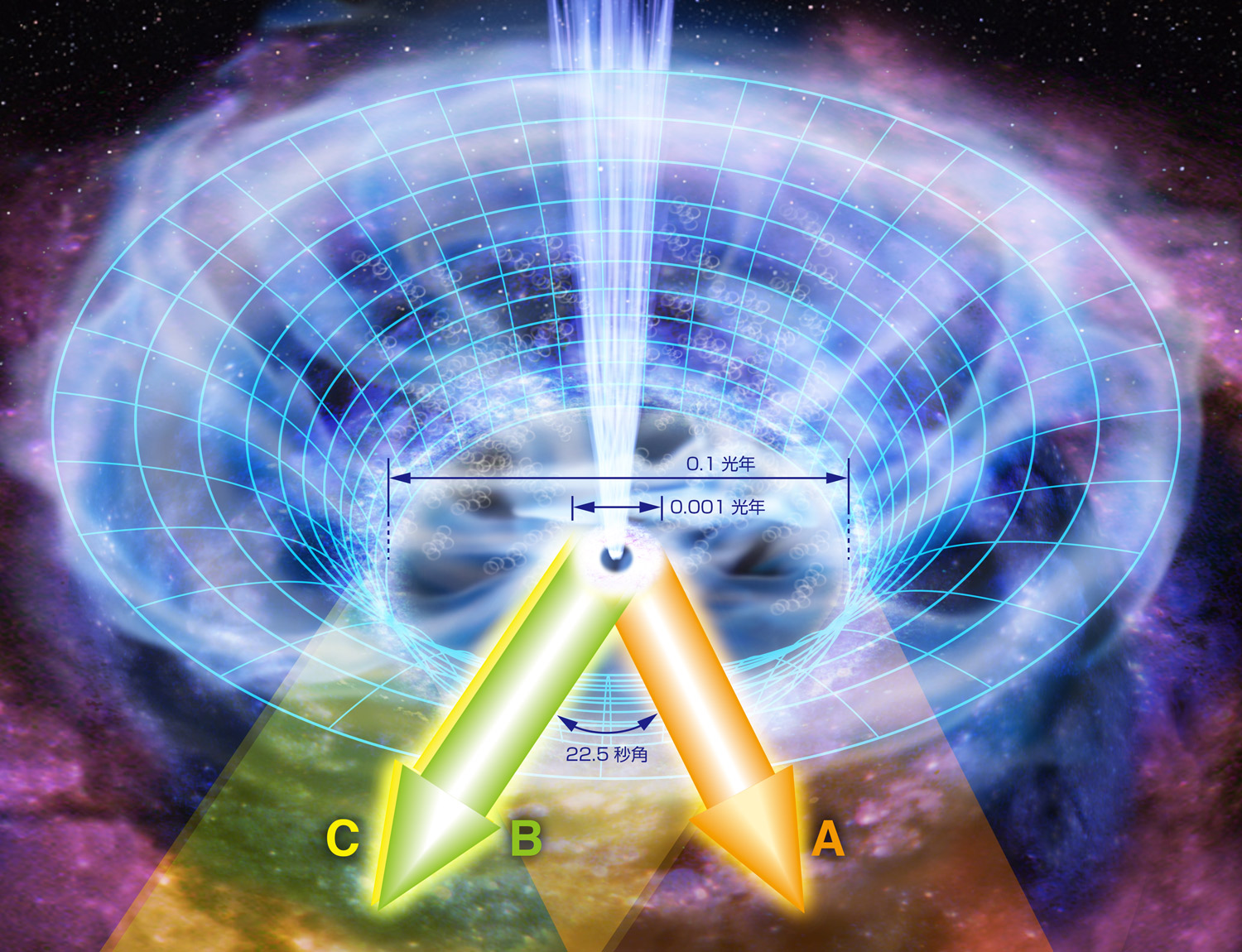
A Japanese team of astronomers, led by Toru Misawa (Shinshu University), has used the Subaru Telescope to observe a distant gravitationally-lensed quasar and probed an active galactic nucleus in its central region. Looking through multiple sight lines, the astronomers obtained a 3-D view of the quasar and discovered complex small structures inside outflows from the galactic nucleus.
Please visit Subaru website for more detail.
(2013/02/20)
T. Misawa, N. Inada, K. Ohsuga, et al. 2013, AJ, 145, 48
[ADS]
[arXiv]
Toru Misawa (Shinshu University)
Ken Ohsuga (private website)
Early thermal X-ray emission from long GRBs
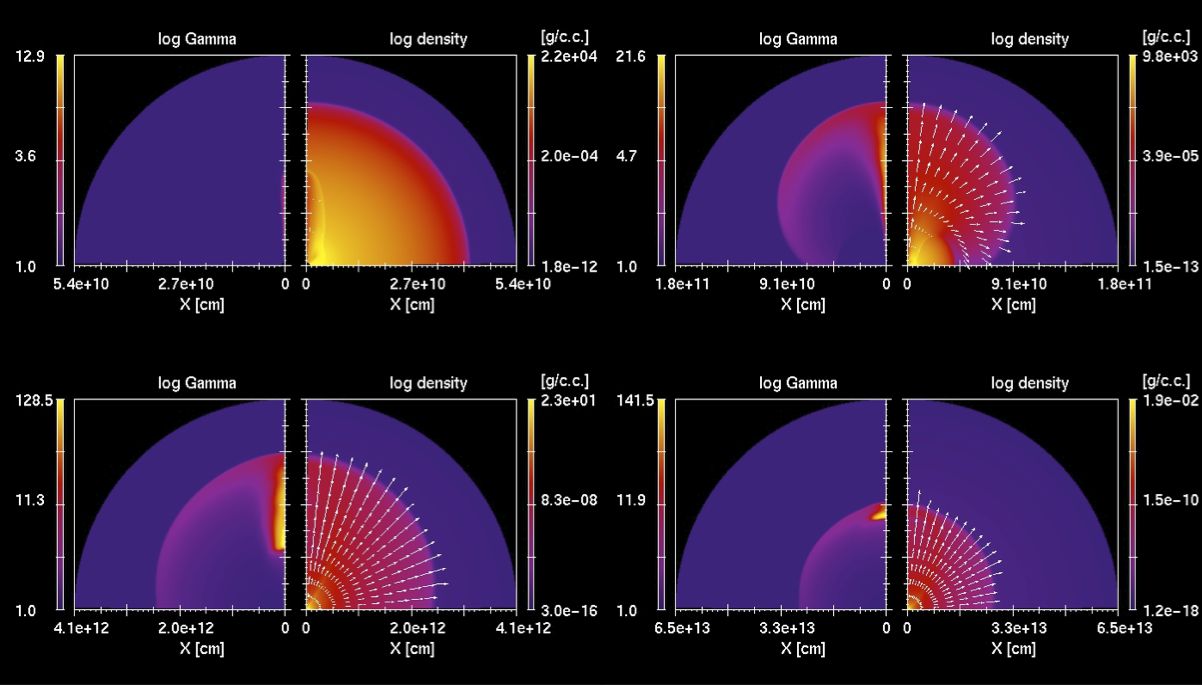
Long gamma-ray bursts (GRBs) are believed to originate from gravitational collapse of massive stars.
Recently, thermal components are found in early X-ray spectra of some GRBs.
In this study, we carried out a series of 2D relativistic hydrodynamical calculations of an ultra-relativistic jet emanating from a massive star.
We calculate expected photospheric emission from the cocoon component forms after the jet breakout from the stellar surface and found that it can explain observed thermal X-ray emission from some GRBs.
Especially, the circumstellar matter surrounding the progenitor star strongly affect some properties, such as the luminosity and the duration, of the emission.
(2013/01/17)
A. Suzuki and T. Shigeyama 2013, ApJL in press (arXiv:1301.2421)
[ADS]
[arXiv]
Akihiro Suzuki (private website)
New Dissipation Mechanism in Collisionless Magnetic
Reconnection
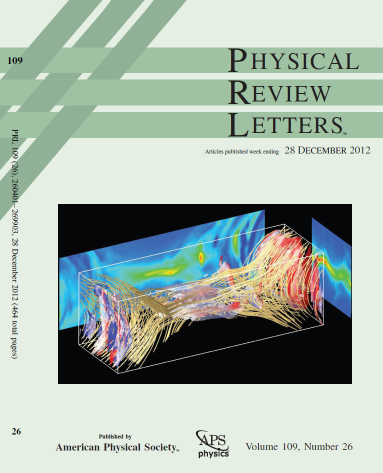
New anomalous dissipation mechanism in collisionless magnetic
reconnection has been discovered by using a large-scale 3D simulation
of plasma in a fully kinetic system. Scientists at NAOJ and Univ
Alberta have demonstrated that the anomalous dissipation increases, in
particular, in association with the enhanced turbulence due to
plasmoid formations. It is expected that the discovery would lead to
the better understanding of explosive phenomena in the Universe by
"embedding" the present result into macroscopic simulations.
(2012/12/28)
K. Fujimoto and R. Sydora 2012, Phys. Rev. Lett., 109, 265004
[DOI]
Keizo Fujimoto (private
website)
Modeling line-driven disk wind for broad absorption lines of
quasars
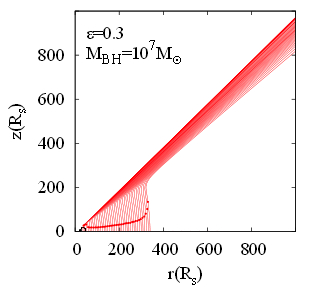
Broad Absorption lines (BALs) observed in the spectra of quasars
indicate the outflows which are different from the jets. The origin of
the outflows is thought to be the disk winds ejected from the surface
of the accretion disk, but the ejection mechanism is still unknown. In
this work, performing the radiation hydrodynamic calculations, we
investigate the structure of the disk wind which is accelerated by the
bound-bound absorption of UV radiation by metals (the line-driven disk
wind). In the figure, we find that the funnel-shaped wind, which is
launched from the surface of the disk (x-axis) surrounding the black
hole (origin). The resulting velocity, ionization parameter and column
density of the wind are consistent with the observations.
(2012/12/20)
Nomura, M., et al. 2012, PASJ in press
[ADS]
[arXiv]
Mariko Nomura (private website)
Exploring Magnetic Field Structure in Star-Forming Cores with
Polarization of Thermal Dust Emission
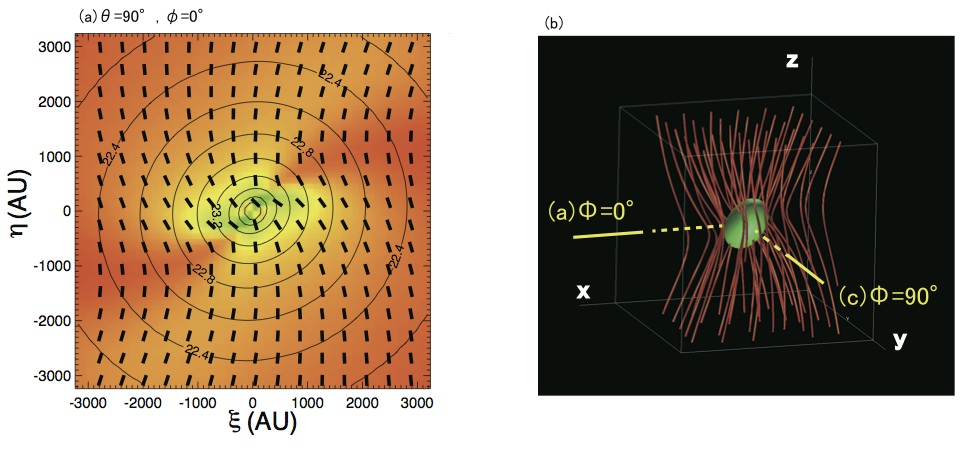
Polarization observation reveals magnetic field structure in
star-forming cores. We “observe” molecular cloud cores in computer,
dynamically simulated using 3D Magneto-Hydro Dynamics, and we clarify
the polarization patterns of star-forming cores.
Especially in case that the initial rotational axis is misaligned with
magnetic field direction, we newly find that magnetic field structure
become "S"-type shape.
(2012/10/30)
Kataoka, A., et al. 2012, ApJ, 761, 40
[ADS]
[arXiv]
Akimasa Kataoka (private
website)
The search for a primordial magnetic field
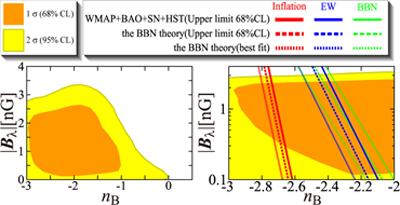
A primordial magnetic field (PMF) would be expected to arise from and/or
influence a variety of cosmological phenomena such as inflation,
cosmic phase transitions, big bang nucleosynthesis, the cosmic microwave
background temperature and polarization anisotropies, the cosmic gravity wave
background, and the formation of large-scale structure.
Scientists at NAOJ, Univ. Notre Dame, and Nagoya Univ.
summarize the current constraints on the PMF
amplitude and the power spectral index,
and discuss prospects for better determining these quantities
in the near future. (Read more detail)
(2012/08/15)
Physics Reports Volume 517, Issue 5, August 2012, Pages 141-167
[Physics Reports]
[arXiv]
Revealing 3D Structure of Supernovae
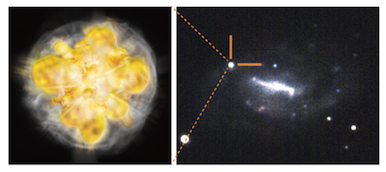
Please visit Subaru website for more detail.
(2012/08/03)
Tanaka, M., et al. 2012, ApJ, 754, 63
[ADS]
[arXiv]
Masaomi Tanaka (private website)
Direct observation of the magnetic reconnection site in a planetary magnetotail
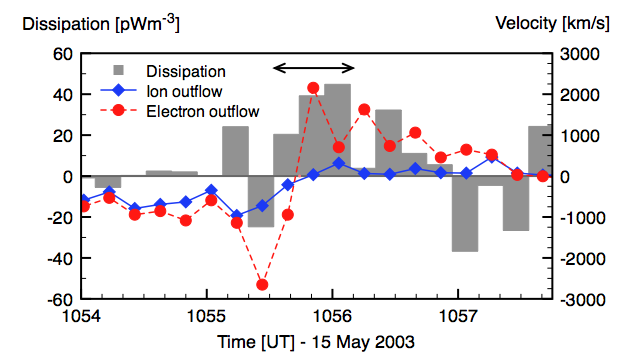
Magnetic reconnection is an important plasma process in space and astrophyiscal plasmas. Scientists at NAOJ, JAXA/ISAS, and Tokyo Tech analyzed a reconnection event in the Earth's magnetital with GEOTAIL spacecraft. They found a compact dissipation region and bi-directional plasma jets. This is the first in situ observation of the innermost dissipation region in a planetary magnetotail and their approarch will be applicable to next-generation observations.
(2012/06/04)
Zenitani, S., et al. 2012, Geophys. Res. Lett., 39, L11102 (2012)
[ADS]
[arXiv]
Seiji Zenitani (private website)
Three-dimensional Core-collapse Supernova
Simulations with Spectral Neutrino Transport
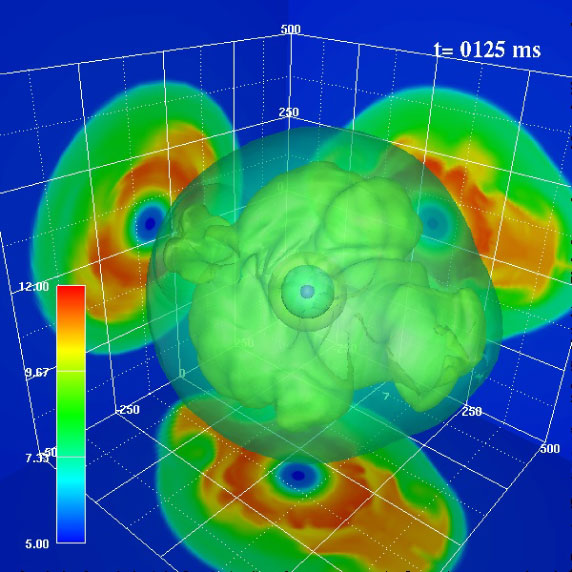
Our knowledge and understanding of the mechanism of core-collapse
supernovae remains incomplete.
Scientists at National Astronomical Observatory have now utilized 3
dimensional hydrodynamical
simulations with spectral neutrino transport to unveil this issue.
Their result indicates that
violent convective matter motions promote the neutrino heating for
successful explosions.
(2012/05/29)
Takiwaki, T., et al. 2012, ApJ, 749, 98
[ADS]
[arXiv]
Tomoya Takiwaki (private website)
FY 2011
Formation of a Propeller Structure by a Moonlet in a Dense Planetary Ring
Shugo Michikoshi, Eiichiro Kokubo
Abstract
Secular Gravitational Instability of a Dust Layer in Shear Turbulence
Shugo Michikoshi, Eiichiro Kokubo, Shu-Ichiro Inutsuka (Nagoya)
Abstract
Gravitional Wave Signatures of Magnetohydrodynamically Driven
Core-collapse Supernova Explosions
Tomoya Takiwaki
Abstract
The inner structure of collisionless magnetic reconnection
Seiji Zenitani
Abstract
There is a wide variety in the research activities in DTA, and it covers a considerable part of modern astronomy. Here we describe activities covered by faculty staff members. Of course, there are a lot of PDs doing independent research in addition to the contents below. There are many interactions beyond the sub-categories in astrophysics in this one of the largest group of theoretical astrophysics in Japan. Ongoing research areas are mainly categorized as follows;
Table of Contents
Star formation has attracted many astronomers, observers and theoreticians. Here, in the Theoretical Astrophysics Division, dynamical process of star formation is studied using hydro- and magnetohydrodynamical simulations. How the fundamental properties of new born stars, such as masses, angular momenta, magnetic fluxes, multiplicity of binaries, and so on, are determined - this is our goal. (Tomisaka)
We have studied the gas and stellar dynamics in galaxies using hydrodynamical and N-body simulations on supercomputers and the GRAPE. We are especially working on multi-phase structure of the inter stellar medium on a galactic scale, energy feedback from star formation, and the starburst-AGN connection. (Wada)
We study any astrophysical phenomena that are related to magnetohydrodynamics (MHD), such as astrophysical jets, star formation, solar atmosphere and so on. Numerical simulation is one of the most powerful tools to study these phenomena. (Kudoh)
Satellite-ring systems are formed around planets as a by-product of planet formation. In the solar system, there is a variety of satellite-ring systems from the single large Moon of the Earth to Saturnian large ring systems with multiple satellites. To clarify the origin and the evolution of these satellite-ring systems is our main goal. We are now studying the origin of a single giant satellite such as the Moon and Charon. (Kokubo)
Satellite-ring systems are formed around planets as a by-product of planet formation. In the solar system, there is a variety of satellite-ring systems from the single large Moon of the Earth to Saturnian large ring systems with multiple satellites. To clarify the origin and the evolution of these satellite-ring systems is our main goal. We are now studying the origin of a single giant satellite such as the Moon and Charon. (Kokubo)
There occurred many physical processes in the early Universe which affect the later cosmic evolution. They are the inflation and subsequent creation of elementary particles, the cosmic phase transitions including quark-hadron transition, the symmetry breaking of four kinds of fundamental forces associated with baryo- and lepto-genesis, the weak decoupling of light neutrino families, and so on. We study these fundamental processes and their effects on the primordial nucleosynthesis, cosmic microwave background anisotropies, and structure formation of various scales theoretically. We aim to construct a universal view of cosmic evolution based on fundamental physics of particles and nuclei so that our theoretical models are established through cosmological observations and physics experiments. (Kajino)
Recent observations of cosmic microwave background anisotropies and Type Ia supernova magnitude-redshift relation have suggested a hypothesis that a flat cosmology of accelerating universal expansion best explains the observed data. What is the nature of dark energy, which manifests a mysterious property of negative pressure and positive energy density? What is the unseen cold dark matter made of, which is still undiscovered experimentally? We try to establish the physical origin of the dark energy, for example as time varying quintessential scalar field, and also identify the dark matter as quantum massive particles required for the spontaneous symmetry breaking or anomaly restoration theoretically. (Kajino)
Brane world cosmology with extra dimensions is motivated by a unified M-theory or superstring theory which manifests Einstein Universe as a hyper-surface (i.e. brane) in higher dimensional manifold. We explore the quantum properties of cold dark matter particles such as the lightest super-symmetric particles in brane world cosmology, and look for their observational signature in cosmic gravitational wave background, cosmic microwave background radiation, Type Ia supernova magnitude-redshift relation, baryon-to-mass ratio of rich clusters, cluster mass-to-light ratio, etc. We also try to parameterize the dark energy as an inflow energy density of scalar field in the bulk. We aim to understand the space-time structure of the brane world cosmology both theoretically and observationally. (Kajino)
Magnetic field, in addition to gravity, plays a critical role in the formation processes of various stellar objects and their dynamical evolution. We study the effects of cosmic magnetic field on the large scale structure. We calculate theoretically the cosmic microwave background anisotropies and their polarization by taking account of the primordial magnetic field in order to constrain the strength and power spectrum at the photon last scattering surface. We then try to model the creation mechanism of the primordial magnetic field in the quark-hadron phase transition or in the inhomogeneous lepton distribution before or after the weak-decoupling of light neutrino flavors. (Kajino)
Even should the cosmic expansion age be determined from observed cosmological parameters, we still need a cosmological clock to date the origin and evolution of hierarchical cosmic structure. Evolution in physical conditions of the early Universe, clusters, galaxies, and stars are represented by the growth or decline in chemical composition of metals which originate from the Big-Bang nucleosynthesis and the later evolutionary cyclic chain of star formation \s nucleosynthesis \s supernova explosion. We first study the nucleosynthesis of the light-to-heavy metals, especially from the rapid- and slow-neutron capture processes and p-process in AGB stars or supernovae. We then apply to describe the metal-enrichment in the Universe in order to construct the best model of the Galactic chemical evolution. We also try to construct the best nucleo-cosmochronometer using long lived radioactive nuclei of heavy metals. (Kajino)
Cosmic shear refers to angular correlations in the apparent shape of distant galaxies arising from the gravitational lensing effect of foreground structures. Via lensing, correlations in the mass distribution are imprinted in the coherent distortions of the galaxy images. Cosmic shear statistics thus provide unique information on the matter distribution and its evolution.
Where is the origin of the rapid-neutron capture elements such as Thorium (half life is 14.05 Gy) and Uranium (4.5 Gy), which are of great use for cosmochronometer, the p-elements, and the super-heavy elements? We have not yet identified astrophysical sites for the r- nor p-elements uniquely although there are several proposed candidate sites such as supernovae, neutron-star mergers, or collapsars (i.e. central engines of gamma-ray bursts). We study the nucleosynthetic origin of these heavy elements by modeling the explosion dynamics of neutrino-driven winds and shock propagation from core-collapse Type II supernovae or accretion disks in collapsars. Both neutral and charge current interactions of neutrinos with nuclei and thereby the induced neutrino oscillation (MSW) effects play the critical roles in the explosive nucleosynthesis in outer layers. We try to determine the neutrino-oscillation parameters in terms of nucleosynthesis of light-to-heavy elements in the neutrino-processes. (Kajino)
Rare light-to-heavy mass elements have several different origins; the Big-Bang nucleosynthesis, the Galactic cosmic-ray interactions with interstellar medium, the supernova gamma- and neutrino-processes, and the AGN jet interactions with gas clouds. We first study the Big-Bang nucleosynthesis in many different ranks of the standard and non-standard cosmological models. We second study the production mechanism of these elements in high-energy Galactic cosmic-rays or AGN jets by modeling realistic source spectra and their propagation through the cold gas clouds. The latter processes are related to the geometrical structure of high-energy AGN activities. We aim to limit these origins quantitatively in order to constrain the most complicated and fundamental physical processes of supernova gamma- and neutrino-nucleosynthesis. (Kajino)
What is the realistic picture of the central engines of gamma-ray bursts? Strongly magnetized compact stellar objects such as rapidly rotating proto-neutron stars or black holes are the viable candidates. We study the interactions of ultra-high-energy charged particles (hadrons) with strong magnetic fields on these relativistic compact objects in quark models. Quantizing the meson field in the constituent quark model, we calculate the meson synchrotron radiation probabilities in strong magnetic field and study the implication in the ultra-high-energy cosmic rays whose energies exceed 1020 eV. (Kajino)
Core-collapse supernovae are among the most energetic explosions in the universe making the catastrophic end of massive stars. Since they are related to the formation of compact objects such as neutron stars, black holes, and magnetars, understanding of their physics has been of wide interest in the astrophysical society. In spite of the importance, one can not still tell the explosion mechanism clearly. By performing the numerical simulations, we study the explosion mechanism and the formation mechanisms of the relevant compact objects, paying particular attention to the effects of stellar rotation and magnetic fields on the neutrino-heating mechanism. (Kotake)
Multidimensional neutrino transport simulations coupled to the magnetohydrodynamics are inevitable to investigate the formation mechanisms of compact objects mentioned above. The fact that neutrinos are fermion with their cross sections being dependent on their energies makes it impossible to find the solution of the Boltzmann neutrino transport equations without the help of the numerical computations. We are developing the formalisms and codes to solve the multidimensional Boltzmann neutrino transfer equation. (Kotake)
When the collapse dynamics in massive stars deviates from the spherical symmetry, gravitational waves (GWs) can be emitted. As for the causes of the asymmetry, stellar rotation has been considered to be most promising. In addition, recent studies suggest that convections, magnetic fields, and anisotropic neutrino radiations can also produce the GWs. By performing the realistic numerical simulations, which take into account the new ingredients, we calculate the waveforms of GWs and discuss their detectability by the currently running laser interferometers, such as TAMA300 and LIGO. Furthermore, we study the gravitational wave background from gamma-ray bursts and the first stars aiming to understand what information about their central engines can be obtained from the GWs. (Kotake)
Neutrino astronomy is becoming reality. In fact, the detection of neutrinos from SN1987A by the Kamioka group was a historical event. More advanced neutrino detectors are running currently. The importance of the study of supernova neutrinos is that one may determine the fundamental properties of neutrinos themselves (such as the mixing angles, mass-hierarchy) by comparing the theoretical predictions with the observations. By studying the neutrino oscillations in the realistic supernova models, we try to put the severe constraint on the unknown neutrino parameters. We also investigate the neutrino interactions in the dense and highly magnetized stellar cores, aiming to study the flare events of the magnetars. (Kotake)
Numerical simulations in astrophysics have to have both high accuracy and wide dynamic range. For example, in the dynamical contraction from a molecular cloud core to a protostar, the density increases ~1013 times while the size decreases ~10-6 times. This comes from the self-gravity. We are developing numerical methods to overcome the above difficulty, which are called Nested-Grid method and Adaptive Mesh Refinement. (Tomisaka)
High-speed and high-accuracy integrators are the essential tool for the study of N-body problems. We are developing time-symmetric and symplectic integrators suitable for planetary N-body problems. (Kokubo)